

March 2011 NewsletterISSN: 1933-8651
In this issue we present the following articles, news, announcements, and reviews:
|
Articles, Essays, and Reports
News and Announcements
Conferences and Calls for Papers
Book Reviews
|
Seizing Freedom:
Archaeology of Escaped Slaves at Camp Nelson, Kentucky
By W. Stephen McBride and Kim A. McBride
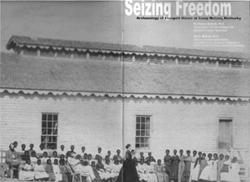
The booklet Seizing Freedom: Archaeology of Escaped Slaves at Camp Nelson, Kentucky, which is reprinted here, tells the story of African American women and children who escaped slavery in Kentucky during the Civil War and entered the U.S. army depot of Camp Nelson. The women and children, along with their husbands and fathers, began entering Camp Nelson in large numbers during the spring of 1864, as the men were attempting to join the U.S. Army. The men were successful in this venture and were emancipated upon joining one of the eight United States Colored Troop regiments organized at Camp Nelson. The women and children, however, who were generally the wives and children of the enlisting soldiers, were initially not successful in attaining their freedom, but many did stay within camp, at least in temporary encampments. It took the tragic November 1864 expulsion of the women and children from Camp Nelson, in which 102 died, to force the federal government to finally emancipate them (in March 1865) and create a more permanent refugee camp, known as the "Home for Colored Refugees."
Archaeological excavations were conducted at both a pre-expulsion refugee encampment and at the "Home for Colored Refugees," and provide new insights into the lives of these women and children. In particular, the archaeology illustrates differences in the women and children's conditions, adaptations, and autonomy in the encampment versus the "Home" and in different settlement situations within the "Home." This booklet was funded by a grant from the National Park Service's National Underground Railroad Network to Freedom Program that also funded archaeology, archival research, and a museum exhibit on these women and children. The exhibit is at Camp Nelson Civil War Heritage Park, which is located near Nicholasville, KY (see campnelson.org for more information). [Read or download this full article here in Adobe .pdf format >>>].
[Return to table of contents]
The Archaeology of Race and African American Resistance
By Christopher N. Matthews
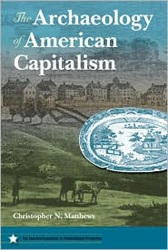
I want to thank Chris Fennell and Christopher Barton for including a chapter from my new book on The Archaeology of American Capitalism published last fall by the University Press of Florida in this issue of the ADAN newsletter. My book is about how archaeology documents the materializations of capitalism in the making of modern America. I consider a range of examples from the New England fur trade to the creation of the modern city to western gold rush and mining communities. I structured the book to illustrate and explain how capitalism was both instituted and resisted in various instances that give great texture of American life past and present.
The chapter reproduced here is my favorite since it exemplifies how I worked to weave together cultural, historical, and political economic factors to produce an archaeological interpretation that highlights both agency and critique. My argument is that capitalism is based on a particular worldview that supports the agency of actors engaged in society as individuals; thus individual agency is a key to participation and to the reproduction of the capitalist system. However, individual agency comes at a price. While many pay this price in labor, debt, and sacrifice, others, usually those most marginal to the mainstream and thus least able to afford the costs of participation, developed alternatives that I consider as critiques. These critiques pointed out the shortcomings and flaws of the system capitalism created, but as I show in the book, most of these critiques failed to generate substantial change as they were adopted by people too heavily invested in that system to see beyond it. My chapter on African Diaspora communities tells a different story by showing how the material culture of African Americans exhibits astute and critical readings of racism and the foundations of capitalism that helped to dehumanize them as slaves and, thus, commodities. Being so marginalized, in other words, African Americans felt and saw what capitalism most expects from its participants and thus were in a unique position to develop a critical standpoint against it.
I also emphasize the importance of considering multivalency in the interpretation of African Diaspora materials. The fact that objects can produce and sustain multiple meanings allowed African Americans to develop autonomous though partly hidden cultural systems informed but not controlled by the white capitalists who surrounded them. Similarly, I highlight the value of considering assemblages so that we are able to consider how artifacts were ordered and related in particular ways that allow us to see the African American cultural critique of capitalism. Finally, I emphasize the social value of religious expression. As religion is based in a community of believers I describe how the material expressions of ritual action and religious belief, from marking colonoware bowls to experiencing conversion in African American Christianity, informs us about how communities critical of racism and capitalism were reproduced through time. Ultimately, I argue that an archaeology of capitalism provides vital insights into the origins and meanings of African American culture from which America as a whole still has so much to learn. [Read or download this full article here in Adobe .pdf format >>>].
[Return to table of contents]
Archaeologists Find Hidden African Side
to Noted 1780s Maryland Building
By Mark P. Leone
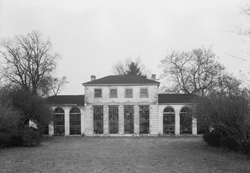 Evidence of Slaves' Technical Skills and Religion at Enlightenment Greenhouse
Evidence of Slaves' Technical Skills and Religion at Enlightenment Greenhouse
One of North America's most famous Revolutionary-era buildings -- a lone-surviving testament to an Enlightenment ideal – has a hidden West African face, University of Maryland archaeologists have discovered.
Their excavation at the 1785 Wye "Orangery" on Maryland's Eastern Shore -- the only 18th century greenhouse left in North America -- reveals that African American slaves played a sophisticated role in its construction and operation. They left behind tangible cultural evidence of their involvement and spiritual traditions.
Frederick Douglass, who lived there as a young man, made it famous through his autobiography. But the team concludes it can build on Douglass to make a more full contribution to understanding.
"For years, this famous Enlightenment structure has been recognized for its European qualities, but it has a hidden African face that we've unearthed," says University of Maryland archaeologist Mark Leone, who led the excavation. "Concealed among the bricks of the furnace that controlled the greenhouse temperature, we found embedded a symbol used in West African spirit practice. An African American slave built the furnace, and left an historic signature."
His team also found an African bundle buried at the entrance to a part of the Wye greenhouse that once served as living quarters for the slaves who maintained the building. [Read or download this full article here in Adobe .pdf format >>>].
[Return to table of contents]
Presentation of the Body: Living and Dead
By Mary Keegan Shia
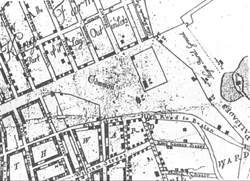
This study concerns the expression of African cultural practices in the population of enslaved persons interred in the African Burial Ground in New York City during the periods of Dutch and British colonial rule. The African Burial Ground was in use from approximately the mid-seventeenth century to the end of the eighteenth century and extended over five to six acres containing between 10,000 and 20,000 graves. A small portion of the burial ground was unearthed in 1991, revealing 418 human remains. I undertake an examination of the grave goods and evidence of the burial positions associated with the individuals recovered from the burial ground during the 1991 excavations, with a specific emphasis on the cosmologies and mortuary practices of the Dutch, British, Akan, Igbo, Yoruba and Fon/Ewe cultures from the seventeenth and eighteenth centuries. By examining these cultural practices in comparison with the findings in the African Burial Ground in New York City, as evident in Perry et. al. (2006) and Medford (2004), this study explores the extent to which members of the enslaved community undertook expressions of particular African cultural practices. The conclusion of this study supports Herskovits' observations concerning the continuing development of African cultures in America and that enslaved Africans were not stripped of their cultures during the Middle Passage of the trans-Atlantic slave trade. I also contend that new cultural beliefs and practices developed and were expressed at the New York African Burial Ground which included elements of both African and Anglo-European cosmologies and traditions. [Read or download this full article here in Adobe .pdf format >>>].
[Return to table of contents]
Dynamics of Metal Working Traditions in West Africa
By Kola Adekola

The development of metallurgy was a turning point in human history in West Africa. The use of metal tools allowed humans to have some control over their environment, and enabled them to transform their settlement patterns, political organizations, and modes of economic production and warfare. Researchers have often speculated that metallurgy techniques were developed earlier in other parts of Africa and the Mediterranean and then introduced through processes of diffusion from outside influences into the cultures of West Africa. West African skills of metal working -- and particularly iron working -- were later transferred to locations in the Americas as a result of the trans-Atlantic slave trade. In this article, I provide evidence of early metallurgy developments within West Africa itself, as seen through a focus on the practice of metallurgy by the Nok culture of central Nigeria. Finally, as to better understand the importance of metallurgy, I discuss the potential discourse between West African archaeologists and those that study African diasporas. [Read or download this full article here in Adobe .pdf format >>>].
[Return to table of contents]
Maroon Archaeology
An Interview with Cheryl White
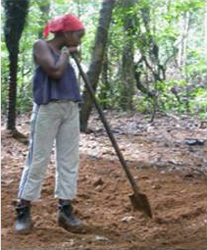
This article presents an edited version of an interview by Dr. Cheryl White on her work in archaeological investigations of free communities of African descendant peoples that have often been referred to as Maroon settlements. The original interview, conducted by editor Anouska Kock, was published on Abeng Central via Word Press on March 18, 2011, and is reproduced here with permission. Settlements of Africans and African descendant peoples who defied slavery in the Americas include those referred to as Maroon communities. Dr. White's discussion demonstrates how people of African descent have incorporated Maroon history into a proud sense of heritage. Such incorporation of this terminology in the development of heritage identities represents instances of proud defiance, as the phrase was originally derived from a derogatory Spanish word of "cimarrone," which designated chattel that had run free. Similar communities of resistance were called palenques in Cuba and quilombos in Brazil. [Read or download this full article here in Adobe .pdf format >>>].
[Return to table of contents]
2011 Archaeological Fieldschools
Addressing African Diaspora Subjects
Compiled By Christopher Barton
The following fieldschool list includes announcements sent to us by the fieldschool directors and others listed on various directories. The fieldschool announcements that follow are presented below in alphabetic order by location, starting with those in North America and then the Caribbean.
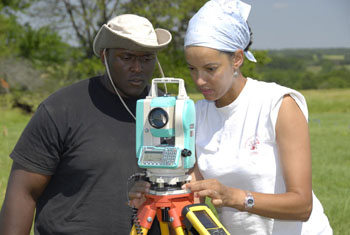
North America
New Philadelphia, Illinois Archaeological Research Project: Fieldschool in Archaeology and Laboratory Techniques. May 24 to July 29, 2011. Sponsored by the National Science Foundation's Research Experiences for Undergraduates Program. Field school co-directors: Anna Agbe-Davies (U. North Carolina), Christopher Fennell (U. Illinois), and Terrance Martin (Illinois State Museum). The New Philadelphia story is both compelling and unique. Many studies in historical archaeology that concentrate on African-American issues have focused on plantation life and the pre-emancipation era. The history of New Philadelphia is very different. It is a chronicle of racial uplift and centering on the success of an African-American family and their ability to survive and prosper in a racist society. In 1836, Frank McWorter, an African American who was born into slavery and later purchased his own freedom, acquired 42 acres of land in the sparsely populated area of Pike County, Illinois, situated in the rolling hills bounded by the Illinois and Mississippi rivers. He founded and platted a town, subdivided the property, and sold lots. McWorter used the revenues from his entrepreneurial efforts to purchase the freedom of sixteen family members, with a total expenditure of $14,000 -- a remarkable achievement. Families of African American and European American heritage moved to the town and created a multi-racial community. New Philadelphia likely served as a stopping place for the "Underground railroad" as enslaved African Americans fled northward escaping the oppression of southern plantations. The history of New Philadelphia serves as a rare example of a multi-racial early farming community on the nation's Midwestern frontier (Walker 1983). Additional information available at: http://www.histarch.uiuc.edu/NSF/fieldschool.html.
Wye River, Maryland. May 31, 2011 to July 8, 2011. This year excavations will be conducted in two locations, on East and Cornhill Streets in the historic district of Annapolis and outside of the city, at the former plantation of Edward Lloyd on the Eastern Shore of the Chesapeake Bay, on Maryland's Wye River. On East Street, we will be excavating at the James Holliday House. James Holliday was born a slave in Anne Arundel County in 1809 and was freed in 1819. He began working for the US Naval Academy in 1845, and purchased the property in 1850. Research questions at this site center around the Holliday family and Annapolis' free African American community.
Wye House is the former plantation is where Frederick Douglass was enslaved as a boy, and is described in his autobiography, My Bondage, My Freedom. Research questions at this site focus on the lives of enslaved people on the plantation. Test excavations were carried out during the summer of 2005, and these verified the location of a former quarter for slaves and the existence of very rich archaeological deposits from Frederick Douglass' time. Intensive excavations at this site began during the summer of 2006, and since that time the remains of three structures associated with enslaved people on the plantation have been excavated. The University of Maryland's Department of Anthropology and the Office of Extended Studies announce the continuation of the Archaeology in Annapolis project. This intensive, six-week field school devotes eight hours daily to supervised archaeological fieldwork, laboratory work, stratigraphic analysis, technical drawing, writing and interpretation. The summer 2011 excavations extend a long-term program of public archaeology in Maryland's state capital that is supported by the Mayor and City Council of Annapolis. This year excavations will be conducted in the City of Annapolis, and outside the City of Annapolis at Wye House, the former plantation of Edward Lloyd on the Eastern Shore of the Chesapeake Bay, on Maryland's Wye River. For further information, contact: Amanda Tang (atang@anth.umd.edu); Jocelyn Knauf (jknauf@anth.umd.edu); Dr. Mark Leone (mleone@anth.umd.edu).
Battle of Island Mound Field School: Interpreting Missouri's Newest State Park: Butler, MO. June 7 to June 28, 2011. The Missouri Department of Natural Resources, the University of Missouri-Kansas City Geosciences Department and the Bates County History Museum are co-sponsoring an archaeological field school June 7 - 28, 2011 in Bates County, Missouri. The field school will be offered through the University of Missouri-Kansas City, and enrollment in the course is a requirement for all participants in the field school. Enrollment is open to all high school graduates or current university students in good academic standing. The recently acquired Battle of Island Mound State Historic Site near Butler, Missouri is significant because it is the location where the first unit of African-American soldiers (1st Kansas Colored Volunteer Infantry) engaged an armed opponent during the Civil War. The property owned by the Missouri State Parks includes the purported sites of the Toothman Farm, from which the black soldiers operated and dubbed "Fort Africa," and a post-war Methodist Episcopal church. In the spring of 2009, a geophysical survey that included magnetometry and electrical resistivity revealed subsurface anomalies consistent with structural remains or foundations of the Toothman house and the church. The survey provided good information, but further archaeological testing is required to verify the presence of farmstead buildings and to enhance interpretation of the site in time for the facility's opening in 2012. This investigation will be the focus of the 2011 Field School. Although this program focuses on Civil War-era and post-bellum archaeological sites, students will receive training in research techniques employed by archaeologists around the world. This field school is valuable to students planning advanced work in archaeology, students seeking employment in contract (CRM) archaeology or who merely want to experience field research in archaeology. To get an information and application packet, or for questions, please contact Ann Raab at raaba@umkc.edu.
Peace College Archaeological Field School at Brunswick Town and Fort Anderson. Brunswick County, North Carolina, United States. May 16, 2011 to June 11, 2011. Application Deadline: April 1, 2011. The 2011 Peace College Archaeological Field School will be held at the North Carolina State Historic Site of Brunswick Town and Fort Anderson, on the banks of the Cape Fear River, from May 16th through June 11th. The site is of unique significance to the history of North Carolina, the United States, and to the history of archaeology. Brunswick Town was a major pre-Revolutionary port on North Carolina's Cape Fear River that was razed by British troops in 1776 and never rebuilt. During the Civil War, Fort Anderson was constructed atop the old village site. The site today is maintained as a North Carolina Historic Site including a museum, colonial-era foundations, and the Civil War earthworks. Most notably, in the 20th century, Brunswick Town was also the site of pioneering work in Historical Archaeology by Dr. Stanley South. Students in the field school will learn methods of archaeological survey and excavation as they uncover the history and culture of the Civil War. In excavating the complex site, students will also encounter colonial and prehistoric materials. Students can take the field school for 4 credits in ANT 450 Archaeological Fieldwork, or students with significant prior field school experience can apply for 4 credits in ANT 495, Advanced Field Methods. As part of the sesquicentennial commemoration of the Civil War in the Cape Fear region, the 2011 field season will continue to seek to define the Civil War barracks associated with Fort Anderson. These barracks were occupied by Confederate and Union soldiers, as well as by African American refugees. For information contact: Dr. Vinnie Melomo at 919-508-2277, or vmelomo@peace.edu.
Archaeology of the Harriet Tubman Home: Auburn, NY. May 16 to May 31, 2011. This summer's archaeological field course will explore Harriet Tubman's House, a National Historic Landmark in Auburn, New York. This course is open to all students and offers both an introduction to archaeological field techniques and historical background into the life of Harriet Tubman and her network of family, friends, and associates. As part of the field program, students will learn basic excavation, survey, mapping, and laboratory techniques. Harriet Tubman is well known for her heroic acts in liberating African Americans from slavery and fighting for emancipation. She has been described as "America's Joan of Arc" and "the Moses of her people." Yet, the full story of her life is little known and her continued, lifelong, commitment to social causes and reform has not found its way into the pages of history -- until now. Contact: Professor Douglas V. Armstrong at darmstrong@maxwell.syr.edu or 315 425-6276.
Historical Archaeology of the Native and African American Community in Setauket, New York. May 24 to June 28, 2011. The Center for Public Archaeology at Hofstra University will be running an archaeological field school during summer 2011 researching the history and archaeology of the Native and African American community of Setauket on Long Island, New York. Descendants of the Setalcott Nation and enslaved Africans, members of this community have been residents of the Setauket area since the 17th century. Over the subsequent centuries, this community formed a substantial component of the working community in the larger region while maintaining key features of their own cultural traditions and history. Students will be learn the details of this history, contribute to documenting new information from the archaeological and historical records, and help to present the project's finding to the public. The field school is part of a collaborative historical, cultural, and archaeological project between Higher Ground Intercultural and Heritage Association, a descendant community based non-profit preservation organization, and Hofstra University. The summer 2011 field school program will be based at the Jacob and Hannah Hart site, a home site occupied from ca. 1870 to 1930 by one of the community's most well-known families. Field school students will work with community members to survey, test, excavate, and analyze the findings from the Hart site. Students will also conduct documentary research in local archives and help to document private collections of community members. For information contact Christopher Matthews at anthczm@hofstra.edu.
Archaeological Field School on Edgefield, South Carolina Pottery Communities. University of Illinois. May 23 to July 1, 2011. The technological innovation of alkaline-glazed stoneware pottery was introduced in North America by potteries operated by Abner and John Landrum in the Edgefield, South Carolina area in the first decades of the 19th century. These technological developments by entrepreneurs of Scots-Irish heritage played out in a landscape shaped by racial difference. Numerous African-American laborers, including "Dave the Potter" who added inscriptions to his vessels, worked at these production sites. Advertisements in local newspapers in the early decades of the 1800s listed enslaved laborers with skills in pottery production. African Americans most likely participated in all phases of the production process, such as: building and maintaining the kilns; digging and transporting clay; working and grinding raw clay in "pug" mills; chopping wood for fuel; preparing glaze mixtures, tempers, and clay pastes; turning the pottery wheels and shaping the vessels; and loading and unloading the kiln firings. This field school will provide training in the techniques of excavation, mapping, controlled surface surveys, artifact classification and contextual interpretation. Students will work in supervised teams, learning to function as members of a field crew, with all of the skills necessary for becoming professional archaeologists. Many students from past University of Illinois field schools have gone on to graduate study and professional field-archaeology positions. Laboratory processing and analysis will be ongoing during the field season. Evening lectures by project staff, visiting archaeologists, and historians will focus on providing background on how field data are used to answer archaeological and historical research questions. For information contact: Christopher Fennell cfennell@illinois.edu; George Calfas gcalfas2@illinois.edu; http://www.histarch.uiuc.edu/Edgefield/.
Montpelier, Virginia: Unearthing a Slave Community. The Archaeology Expedition program has been operating at Montpelier for a decade-and-a-half, with many of the same volunteers returning year after year. We are, however, keen to add new faces to the program. All of the scheduled programs are designed to give participants actual excavation experience on an archaeological site working side-by-side with trained professional archaeologists. We have a staff of eight archaeologists who work with participants both in the lab and in the field, which means you have personal interaction with archaeological staff and this allows you to work on sensitive features, artifacts, and deposits that normally one would not get to handle. You are treated as a member of the research team and we step you through the entire excavation process. While you are here at Montpelier, you will be engaged in lectures, take tours of various archaeological sites on the property, and of course get a tour of the mansion.
Over the next three years, the Montpelier Foundation will be conducting archaeological investigations of various households that were part of the early 19th-century (1810s to 1830s) enslaved community at Montpelier. Three different living areas for the enslaved community have been identified in Montpelier's 1,250-acre historic core that in the early 19th century was called the Home Quarter: 1) The South Yard - the quarters for house slaves who resided within the formal grounds of the mansion, 2) The Stable quarter -- a set of quarters associated with the operations of the mansion household which appear to have included those enslaved individuals working as gardeners or in the stables and 3) The Field quarter -- the quarters for field slaves located in the heart of the working complex for the Home Quarter. During the 2011 field season, we will be excavating the Quarters for House Slaves located in the South Yard of the mansion. During the 2011 excavations, archaeology team members will be looking for and excavating the yards and structures of the slave quarters, and discovering a myriad of ceramics, glasswares, and other objects used and owned by the slave community at Montpelier. There are a total of nine Archaeological Expedition programs in the 2011 field season: Session 1, March 27-April 2; Session 2, April 10-16; Session 3, May 1-7; Session 4, July 31-August 6; Session 5, August 7-13; Session 6, August 14-20; Session 7, August 21-27; Session 8, September 11-17; Session 9, October 23-29. For more information on any of these programs, please contact Dr. Matthew Reeves, Director of Archaeology at James Madison's Montpelier, mreeves@montpelier.org, or (540) 672-2728 x160.
A Unique Learning Experience at Thomas Jefferson's Retreat: Poplar Forest, Virginia. June 5 to July 8, 2011. Thomas Jefferson's Poplar Forest and the University of Virginia are pleased to offer the Twenty-Third Annual Summer Field School in Historical Archaeology. The field school provides a foundation in current methods and theories of historical archaeology, and offers a solid introduction to the practical skills of site survey, excavation, recording, and laboratory procedures. Students will actively participate in our ongoing interpretation of archaeology to the public. In the summer of 2011, field school participants will excavate an early nineteenth-century building complex, believed to be associated with plantation work spaces and possibly slave quarters, adjacent to Jefferson's ornamental grounds. Application Deadline: April 7, 2011. Contact Jack Gary, Director of Archaeology and Landscapes, Poplar Forest, P.O. Box 419, Forest, VA 24551.
The Archaeology of Chesapeake Slavery and Landscape, Charlottesville, Virginia, United States. June 6, 2011 to July 15, 2011. Application Deadline: March 25, 2011. Our fieldwork addresses changing patterns of land use and settlement on Thomas Jefferson's Monticello Plantation from c. 1750 to 1860. Toward the end of the 18th century, spurred by shifts in the Atlantic economy, Thomas Jefferson and planters across the Chesapeake region replaced tobacco cultivation with a more diversified agricultural regime, based around wheat. Our research is revealing the implications of this shift for the landscape and for the lives of enslaved African Americans. Significant questions remain about the ecological processes that resulted, how they were experienced by slaves and slave owners, and the importance of changing slave work routines in explaining social dynamics among enslaved and free people. Field school students will focus on the exploration of how the domestic lives of slaves changed during the shift from tobacco to wheat cultivation. Students will learn archaeological excavation and recording techniques required by multi-disciplinary field research in landscape archaeology. Technical topics covered include survey and excavation strategies, the analytical possibilities for ceramics, faunal remains, plant phytoliths and pollen, deposits and the sediments they contain, soil chemistry, and spatial distributions of artifacts. The field school emphasizes multidisciplinary approach to archaeology. Guest lecturers are drawn from a variety of disciplines including geology, zooarchaeology, palynology, architectural history, and social history. On-site instruction, lectures, and discussion sessions at Monticello will be complemented by field trips to related sites. Students will attend classes forty hours per week, with the bulk of that time spent doing on-site field research. Reading assignments, lectures, and discussion will cover both technical and historical issues. Most weekends are free for individual travel. All students in the field school will receive a Monticello Archaeological Scholarship from the Thomas Jefferson Foundation. This tuition grant covers one-half of the normal University of Virginia tuition charge. For information contact: Fraser D. Neiman fneiman@monticello.org.
Dismal Swamp National Wildlife Refuge, Virginia and North Carolina. May 17 to July 2, 2011. The Great Dismal Swamp has a complex and deep social history. Indigenous Americans inhabited the swamp for several millennia prior to colonial occupation in the region (early 17th century). Subsequently, its recesses were home to thousands of Indigenous and African Americans who had escaped the brutalities of colonialism, indentured servitude, and slavery. Included among these groups were maroons, or African-Americans who permanently extricated themselves from the conditions of enslavement. After 1800, corporations found profitability in the swamp through the labors of enslaved African-Americans. In all, a poorly documented and secret human world existed in the swamp between 1600 and the Civil War. The historical archaeology being done through the Great Dismal Swamp Landscape Study is bringing the history of these people and their communities to light. For information contact: Daniel O. Sayers at sayers@american.edu.
University of Mary Washington's 17th Field School in Archaeology at Stratford Hall Plantation, Virginia. May 16 to June 17, 2011. Stratford Hall's long-term research program includes the archaeological analysis of the plantation's historical landscape and community. Stratford, the 18th-century home of the Lee family, is located in Westmoreland County on a 1,700-acre tract along the Potomac River, approximately 40 miles southeast of Fredericksburg, VA. The Stratford mansion is one of the best-known examples of Georgian architecture in America (www.stratfordhall.org). The field school allows participants to gain proficiency in excavation, recording, and field interpretation, and will include instruction in the method and theory of archaeology. This year's field research focuses on a mid-18th –century farm quarter complex, a site associated with the plantation's free and enslaved workers. This site is interpreted in relation to the broader plantation landscape of buildings and agricultural fields. The field school's overall goal has been to examine the structure and evolution of this landscape, as well as its cultural use and historical meaning. The five-week field school carries four hours of either undergraduate or graduate credit. For information contact: Douglas W. Sanford at dsanford@umw.edu.
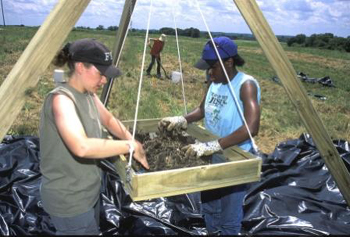
Caribbean
Antigua -- A three-week summer field school is being offered through California State University, Chico. May 26 to June 16, 2011. The field school is located on the Caribbean island of Antigua, at Betty's Hope, a former sugar plantation with existing structures and a small museum located on site. The program offers 3 units of course credit for archaeological fieldwork as ANTH 398 (Special Topics). The main goals of the field school are to provide hands-on training and experience in archaeological fieldwork. The field school will allow students to apply their academic training to practical use through excavation, mapping, surveying, data collection, as well as, analysis and the processing of archaeological recovered materials. Betty's Hope operated from 1651until its sale by the Codrington family in 1944; the plantation operated continuously for almost 300 years, pre- and post-emancipation, thus allowing for a long-term, albeit complex, historical continuity in one place. The site is also a tourist destination, so students can experience aspects of public archaeology at the site. The field school will comprise field archaeology, lectures on Antigua's English colonial history and historical archaeology, as well as some weekend fieldtrips. Working on the island will also allow students to experience contemporary Caribbean culture, thus gaining an appreciation for the Antiguan people and culture. Field work will be complemented by access to local beaches after a busy day in the field. The field school runs from May 26-June 16.
St. Eustatius Center for Archaeological Research (SECAR). January to August 2011. St. Eustatius (or Statia) was the primary trans-shipment center between Europe, the West Indies and the Americas between 1770 and 1800. For much of the American Revolution, Holland and France supplied US forces with much needed arms and ammunition through this port. Archaeological investigations of Colonial Period slave sites in the Americas and Africa have been thorough in answering wide-ranging questions regarding slave life and culture. However, this research has primarily focused on sites in the British, Spanish, French and Danish colonies. No slave occupation sites in the Dutch Caribbean Colonies have been excavated until now. For information contact: Email: info@secar.org.
Magens House, St. Thomas, United States Virgin Island. June 4 to June 19, 2011. Cinnamon Bay, Artifact Analysis. Students will be also be involved in the analysis of artifacts from the shoreline ruins of an early cotton estate located at Cinnamon Bay. The Cinnamon Bay project explores a small-scale cotton plantation, provisioning and maritime estate dating back to the to the late 17th century. This site was later part of a much larger 18th and 19th century sugar estate. The early site affords us the opportunity to examine artifacts reflecting the interaction between enslaved Africans and European planters from the beginning of formal colonial settlement of the island. In 2000 and 2001 Syracuse excavated the ruins of an early wattle-and-mortar laborers house and a building that served as both a planter residence and planter residence and storehouse. Initial analysis has shown that the early deposits from these sites date back to the late 17th century, an era prior to formal settlement of the island by the Danish, and include significant evidence from when the buildings were burnt during the St. John rebellion in 1733.
This site provides an excellent opportunity to examine social relations among Africans and Europeans living in close quarters in a small scale beachhead setting prior to formal colonization, transitions under the colonial regime, the localized impact of the slave rebellion of 1733, and the transition to a larger scale sugar based plantation system on the island (initiated with formal colonization in 1718 and consolidated in the years immediately preceding and following the rebellion of 1733. The archaeological study of the early shoreling settlement at Cinnamon bay will be the first to focus primarily on a cotton estate and will provide a baseline for the study of contrasts in scales of plantations and social interaction in plantation settings. The study builds on a growing body of archaeological and historical research examining African-Caribbean living contexts and plantations (Armstrong 1985, 1990, 1998, Farnsworth 1992; Gartley 1979; Knight 1999; Pulsipher and Godwin 1982; Handler and Lange 1978). For information contact: Professor Douglas Armstrong at darmstrong@maxwell.syr.edu or 315 425-6276.
[Return to table of contents]
Many U.S. Blacks Moving to South, Reversing Trend
By Sabrina Tavernise and Robert Gebeloff
Posted online March 24, 2011 by the New York Times at
http://www.nytimes.com/2011/03/25/us/25south.html
Copyright 2011 New York Times.
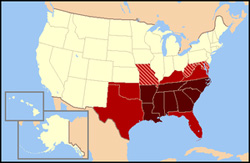
Washington, DC. -- The percentage of the nation's black population living in the South has hit its highest point in half a century, according to census data released Thursday, as younger and more educated black residents move out of declining cities in the Northeast and Midwest in search of better opportunities.
The share of black population growth that has occurred in the South over the past decade -- the highest since 1910, before the Great Migration of blacks to the North -- has upended some long-held assumptions.
Both Michigan and Illinois, whose cities have rich black cultural traditions, showed an overall loss of blacks for the first time, said William Frey, the chief demographer at the Brookings Institution.
And Atlanta, for the first time, has replaced Chicago as the metro area with the largest number of African-Americans after New York. About 17 percent of blacks who moved to the South in the past decade left New York State, far more than from any other state, the census data show.
At the same time, blacks have begun leaving cities for more affluent suburbs in large numbers, much like generations of whites before them.
"The notion of the North and its cities as the promised land has been a powerful part of African-American life, culture and history, and now it all seems to be passing by," said Clement Price, a professor of history at Rutgers-Newark. "The black urban experience has essentially lost its appeal with blacks in America."
During the turbulent 1960s, black population growth ground to a halt in the South, and Southern states claimed less than 10 percent of the national increase then. The South has increasingly claimed a greater share of black population growth since -- about half the country's total in the 1970s, two-thirds in the 1990s and three-quarters in the decade that just ended.
The percentage of black Americans living in the South is still far lower than before the Great Migration in the earlier part of the last century, when 90 percent did. Today it is 57 percent, the highest since 1960.
"This is the decade of black flight," said Mr. Frey. "It's a new age for African-Americans. It's long overdue, but it seems to be happening."
The five counties with the largest black populations in 2000 -- Cook in Illinois, Los Angeles, Wayne in Michigan, Kings in New York and Philadelphia -- all lost black population in the last decade. Among the 25 counties with the biggest increase in black population, three-quarters are in the South. [Read this full article online at the New York Times. Read a related, earlier article on such trends from this Newsletter by Maggi M. Morehouse, entitled "'Smiling Faces, Beautiful Places:' Stories of African Diaspora Relocation to the South."]
[Return to table of contents]
Launch of Website for Slavery Memorial
Important Step Forward, Says Ban
By United Nations News
Posted online February 1, 2011
http://www.un.org/
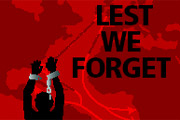
February 1, 2011 -- Secretary-General Ban Ki-moon today lauded the launch of a website for the permanent memorial honouring the victims of slavery and the transatlantic slave trade, calling it an important step forward in making the memorial a reality at the United Nations Headquarters complex.
The memorial is a reminder that millions of Africans were violently removed from their homelands, ruthlessly abused and robbed of their dignity, Mr. Ban said in a message delivered on his behalf by Kiyo Akasaka, the Under-Secretary-General for Communications and Public Information, at the inauguration of the website.
"The memorial will also remind the world of the bravery of those slaves, abolitionists and unsung heroes who managed to rise up against an oppressive system and end the practice," the Secretary-General said, adding that it will also serve as a call to action against contemporary manifestations of slavery.
Mr. Ban noted that the abolition of the transatlantic slave trade in the 19th century did not eradicate the practice globally.
Slavery continues to manifest itself in such exploitative practices as serfdom, debt bondage and forced and bonded labour; trafficking in women and children, domestic slavery and forced prostitution, including of children; sexual slavery, forced marriage and the sale of wives; child labour and child servitude, Mr. Ban said.
"This reality obliges the international community to bring perpetrators to justice and to continue pursuing with vigour its efforts to uphold human rights and human dignity," he added.
He praised Jamaica, the Caribbean Community (CARICOM) and the African Group for their initiative to set up the permanent memorial and for creating the website that will advance that effort. He also thanked all Governments that have made financial contributions to the project and encouraged others to follow suit.
Ambassador Raymond Wolfe of Jamaica is heading efforts to erect the memorial, while a committee of interested States is also participating in the trust fund set up in 2009 to pay for the construction. An estimated $4.5 million is needed if the memorial is to be erected by 2012.
[Return to table of contents]
Educators Learn Ways to Impart
Lessons of Slavery to Future
Generations
By United Nations News
Posted online March 23, 2011
http://www.un.org/
From high schools in the Gambia and Portugal to pre-schools in South Africa and a university in the United States, hundreds of teachers and educators from around the world gathered "virtually" today through the assistance of the United Nations to learn about the best ways to teach future generations about slavery.
The one-day video conference, which brought together around 450 people at seven different sites worldwide, gave participants the opportunity to exchange the latest ideas, successes and strategies for teaching the subject at all levels of the education system.
The virtual gathering is one of a series of events being staged by the UN this week to mark the International Day of Remembrance of the Victims of Slavery and the Transatlantic Slave Trade, which will be formally observed on Friday. It follows the success of a similar event last year that was aimed at students.
Yvonne Acosta, the chief of education outreach in the UN's Department of Public Information (DPI), said the organizers hope that the video conference had a multiplier effect beyond the actual participants.
"We're hoping that in addition to the teachers [participating], they will take it back and share it with their students" for years to come, she said. "That's more than we would otherwise reach."
Based on feedback from today's event, the organizers -- who have been helped by the UN Educational, Scientific and Cultural Organization (UNESCO) -- are considering staging similar events for educators on other subjects.
Professor Sir Hilary Beckles of the University of West Indies, considered one of the world's foremost experts in the field, told the UN News Centre that he can remember a time when teaching slavery was dismissed or marginalized, even within the academy.
"I think there was a tremendous amount of resistance," Professor Sir Hilary recalled, citing UNESCO's Slave Route Project -- created in 1994 to boost awareness about the issue -- as a turning point.
"That project brought legitimacy to the discourse. It broke the silence and gave confidence to a generation of scholars to move away from validating academic racism."
Another crucial factor, Professor Sir Hilary said, was the way that teachers re-framed the subject from explaining it as merely an economic institution to showing its cultural, social and personal effects.
"We started teaching the human side, the social side, the biographical side . . . and the world started to identify with their own stories."
The impact of the transatlantic slave trade lingers even today, more than a century after it ended, he noted, in the economic and power relations between countries and peoples.
"This is a subject that should be of interest to anyone interested in the modern world and how it was shaped."
[Return to table of contents]
Portsmouth, New Hampshire Memorializes
18th Century African Burying Ground
By Valerie Cunningham
Posted online February 28, 2011
Copyright 2011 National Trust for Historic Preservation.
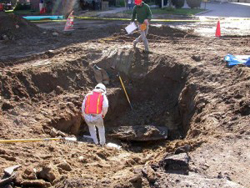
In October 2003, contractors carrying out infrastructure upgrades near the intersection of Court and Chestnut Streets in downtown Portsmouth, New Hampshire unearthed fragments of wood coffins. Under the direction of the state archaeologist, a total of 13 coffins were identified at the excavated site and eight were temporarily removed. Archaeological, historical and scientific protocols were followed throughout this process and a team of researchers analyzed the historic records, artifacts and skeletal remains, as well as DNA samples. The findings of the combined research confirmed that this site was the "Negro Burying Ground" as shown on a 1705 city map.
This segregated colonial-era burying place for Africans was located in what was then an undeveloped area on the outskirts of town. As residential Portsmouth expanded during the 1790s, the burying ground was subsumed into the urban landscape where as many as 200 graves may still lie.
Revelation of the burying ground has distinction as the earliest documented African-American cemetery in New England. The memorial brings attention to nearly 400 years of black history in New Hampshire, from the first recorded arrival of an African in 1645 to the modern Civil Rights Movement. The African Burying Ground always has been a focal point of the Portsmouth Black Heritage Trail linking 24 sites around the city that tell stories of its African people.
To determine how best to honor those unmarked and unidentified graves beneath Chestnut Street, the mayor appointed a blue ribbon committee, chaired by Vernis Jackson, founder and president of the Seacoast African American Cultural Center. The African Burying Ground Committee met with owners of property adjacent to the city's excavated site and agreed that Chestnut Street should be closed to through traffic and that a memorial park would be created at the site.
The city contracted Woodburn and Company, to assist the African Burying Ground Committee with the landscape design of a memorial park. The location presents particularly complex design challenges because of the sloping topography, the need to allow access to private property and, especially, because additional human remains is known to be buried there at very shallow depths.
The committee reached out to the community during the design process via a series of public forums and, following a national search, added artist and sculptor Jerome Meadows of Meadowlark Studios in Savannah, Georgia, to the design team.
The design phase concluded in 2009 when the mayor and Portsmouth City Council endorsed the African Burying Ground Committee's recommended design, entitled "We Stand in Honor of Those Forgotten." The roughly 6,500-square foot African Burying Ground Memorial Park includes sculptural pieces, historical information, granite seating walls, landscaping and pedestrian scale lighting. A community plaza will feature decorative tiles to be made by local schoolchildren under the direction of artist Meadows.
A timeline embedded in the park's cobbled walkway will reference the 20 African men from Portsmouth households who petitioned the New Hampshire legislature, unsuccessfully, for their freedom in 1779. The remains of the eight individuals exhumed when the burying ground was accidentally disturbed will be re-interred in the meditation area of the park. Their sealed vault will be marked with the West African sankofa symbol which means "to learn from the past."
The African Burying Ground Committee has begun what is expected to be an 18-month fundraising campaign for the $1.2 million project. The Portsmouth City Council has allocated $100,000 in Urban Development Action Grant (UDAG) funds toward development of the memorial park. UDAG funds are non-property-tax dollars, which are typically used for community enhancement and economic development projects.
At the request of the African Burying Ground Committee, the city council has also established the African Burying Ground Trust Fund, managed by Art-Speak, the city's non-profit cultural commission. The trust fund will serve as a repository to receive tax-deductible contributions for the construction and maintenance of the African Burying Ground Memorial Park.
Valerie Cunningham is founder of the Portsmouth Black Heritage Trail and a member of the mayor's African Burying Ground Committee.
[Return to table of contents]
The Thorny Path to a National Black Museum
By Kate Taylor
Posted online January 22, 2011 by the New York Times at
http://www.nytimes.com/2011/01/23/us/23smithsonian.html
Copyright 2011 New York Times.
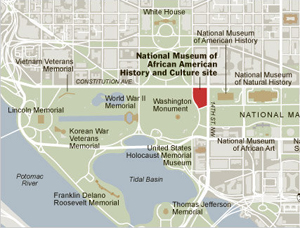
In the late 1970s, when Lonnie G. Bunch III had his first job at the Smithsonian's National Air and Space Museum, veterans of the Tuskegee Airmen, the all-black squadron, accused the museum of playing down their contributions during World War II. In response, the museum asked some of the African-Americans on staff to allow their faces to be used on mannequins, increasing the "black presence" in its exhibits.
"I didn't do it," Mr. Bunch said recently, who was among those asked. "That's not the way I wanted to be part of a museum."
Thirty years later Mr. Bunch, and African-American history itself, are part of a Smithsonian museum, but in a very different way. As the director of the National Museum of African American History and Culture, Mr. Bunch, 58, is charged with creating an institution that embodies the story of black life in America.
The pressure couldn't be greater. To open in 2015, in a $500 million building designed to evoke the art of an ancient West African kingdom, the museum will stand at the geographic center of American civic identity, on the National Mall.
Since Mr. Bunch was appointed in 2005 -- two years after the museum was created by an act of Congress -- he and his staff have been racing at full speed, commissioning the building, amassing a collection, reaching out to potential donors and future visitors. But as their deadline approaches, and grand dreams have to be refined into gallery layouts and exhibition plans, they are not only juggling details and a $250 million fund-raising campaign, but also grappling with fundamental questions about the museum's soul and message.
Among the biggest, of course, is: What story will it tell? As part of the Smithsonian, the museum bears the burden of being the "official" -- that is, the government's -- version of black history, but it will also carry the hopes and aspirations of African-Americans. Will its tale be primarily one of pain, focused on America's history of slavery and racial oppression, and memorializing black suffering? Or will it emphasize the uplifting part of the story, highlighting the richness of African-American culture, celebrating the bravery of civil rights heroes and documenting black "firsts" in fields like music, art, science and sports? Will the story end with the country's having overcome its shameful history and approaching a state of racial harmony and equality? Or will the museum argue that the legacy of racism is still dominant -- and, if so, how will it make that case? [Read this full article online at the New York Times.]
[Return to table of contents]
NOAA, Partners, Launch New Website
Highlighting African-American Maritime Heritage
By National Oceanic and Atmospheric Administration
Posted online February 1, 2011 by NOAA.
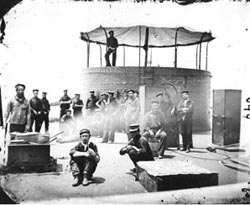
NOAA's Office of National Marine Sanctuaries, in partnership with Murrain Associates, Inc., and the National Association of Black Scuba Divers (NABS), today launched Voyage to Discovery, a new website and education initiative highlighting untold stories of African-Americans and the sea.
Aimed at everyone from students to adults, the Voyage to Discovery website offers feature stories, interviews, and videos about African-American seafaring achievements since the period of pre-Civil War to today. Information about marine careers will also be available.
The website is part of a broader NOAA initiative to build public awareness about the legacy of African-American maritime heritage and engage a broad spectrum of Americans in the stewardship of the country's coastal and ocean resources through education, archaeology, science and underwater exploration.
Daniel J. Basta, director, NOAA's Office of National Marine Sanctuaries, said the Voyage to Discovery education initiative honors African-Americans' deep connection to the sea and highlights the continuing, historic role of the ocean in the security, stability and prosperity of the nation.
"Our economy and way of life are inextricably linked to the health and productivity of the global ocean," Basta said. "Through this initiative, African-American youth can learn about their maritime heritage and the various educational and career opportunities that exist in the 21st century global economy."
Michael H. Cottman, a NABS member and author of "The Wreck of the Henrietta Marie," said he hopes Voyage to Discovery will inspire young adults to identify with their maritime roots and consider careers in marine science and oceanography.
"Minorities are the fastest growing population in the country, but are vastly underrepresented in science and technology fields," Cottman said. "In order for the U.S. to maintain its competitive edge, the future workforce will need to draw on the minds and talents of all its citizens."
As far back as the American Revolution, blacks have been involved in virtually every aspect of maritime work. Despite an uncertain and sometimes dangerous racial climate, blacks worked as skippers and captains as well as whalers, lobstermen and fishermen. They also managed lighthouses, steered paddleboats and warships, along with owning sea industry businesses. The Underground Railroad used ships to spirit slaves to freedom, and black mariners helped shaped the identity of free black communities.
Among the people profiled on the website: Captain Absalom Boston, a free black born in 1785 who led an all-black crew aboard the whaling schooner Industry and amassed substantial real estate holdings. Robert Smalls, a slave who became a Civil War hero in the Union Navy and served as a congressman from South Carolina during Reconstruction. Rear Admiral Evelyn Fields, the first African-American and first woman to become director of the National Oceanic and Atmospheric Administration Commissioned Officers Corps, the nation's seventh uniformed service.
Bill Murrain, founder of Murrain Associates, said the ocean and marine environment provides a wealth of services that are vital to communities nationwide.
"The rich, untold history that is chronicled throughout this project is a reminder that all of us have a responsibility to keep our ocean and waterways healthy so future generations will continue to reap the benefits," he said.
The National Association of Black Scuba Divers was established in 1991 to foster camaraderie among black divers and to address the unique problems and concerns of the African-American community. The organization has more than 2,000 members across the country and internationally. Membership is open to anyone regardless of race, color, gender, physical challenges or diving agency affiliation.
Murrain Associates Inc. is a management consulting firm with a focus on strategic planning, project evaluation, community development, health services planning, assessment and management. Murrain Associates consists of three members of the National Association of Black Scuba Divers who have shared experiences in marine biology, marine archaeology, slave ship exploration, history, law, journalism and marketing. The founder of Murrain Associates is Bill Murrain, a lawyer based in Atlanta, Ga.
NOAA's Office of National Marine Sanctuaries manages a system of 14 marine protected areas covering more than 150,000 square miles of ocean and Great Lakes waters. The Maritime Heritage program promotes appreciation and protection of the country's maritime heritage resources including historic shipwrecks and prehistoric archaeological sites, archival documents, oral histories, and traditional seafaring and ecological knowledge of indigenous cultures.
NOAA's mission is to understand and predict changes in the Earth's environment, from the depths of the ocean to the surface of the sun, and to conserve and manage our coastal and marine resources.
[Return to table of contents]
New Book
Repercussions of the Atlantic Slave Trade:
The Interior of the Bight of Biafra and the African Diaspora
Edited by Carolyn A. Brown and Paul E. Lovejoy
Africa World Press, Paperback
400 pp., ISBN-13: 978-1592213580, 2010.
Description from the Publisher:
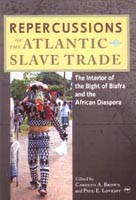 This volume looks at the historical context of slavery in the interior of the Bight of Biafra and the resulting diaspora of people that was formed in the Americas. The Bight of Biafra has a sordid yet fascinating history because of the intense connection with slavery, first as one of the main sources of enslaved labor for the Americas and then because of the continuation of forms of slavery into the nineteenth and twentieth century. Enslaved victims figured prominently in trade in the interior of the Bight of Biafra from at least the early eighteenth century and probably earlier still. The scale of enslavement was massive, accounting for the 1.6 million people who were forced to embark on slave ships for the Americas. If the numbers of people who were enslaved but never left the region are also included, than the total demographic displacement through slavery was considerably more than this figure. The contributors to the volume include scholars from universities in Nigeria, Europe and North America and are based on a conference held in Nigeria in 2000.
This volume looks at the historical context of slavery in the interior of the Bight of Biafra and the resulting diaspora of people that was formed in the Americas. The Bight of Biafra has a sordid yet fascinating history because of the intense connection with slavery, first as one of the main sources of enslaved labor for the Americas and then because of the continuation of forms of slavery into the nineteenth and twentieth century. Enslaved victims figured prominently in trade in the interior of the Bight of Biafra from at least the early eighteenth century and probably earlier still. The scale of enslavement was massive, accounting for the 1.6 million people who were forced to embark on slave ships for the Americas. If the numbers of people who were enslaved but never left the region are also included, than the total demographic displacement through slavery was considerably more than this figure. The contributors to the volume include scholars from universities in Nigeria, Europe and North America and are based on a conference held in Nigeria in 2000.
[Return to table of contents]
New Book
The African Diaspora in Asian
Trade Routes and Cultural Memories
By Shihan De Jayasuriya Silva
Edwin Mellon Press, Hardback
198 pp., ISBN-13: 97-80773436510, 2010.
Description from the Publisher:
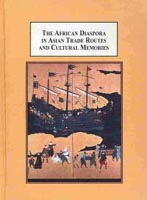 With increase of migration, diaspora studies have become a more significant part of global history. This book contributes to building a more comprehensive narrative of the global African movement. Concerned with Africans who migrated beyond the Indian Ocean, even to China and Japan, the book aims to stimulate scholarship on African movement to Asia and also to increase awareness of the history of Afro-Asian communities who still live in isolated pockets of Asia. Uncovering a slave route from Madagascar to Sumatra, the author identifies points of origin of slaves -- Mozambique, Madagascar, Angola. The author argues that Africans played a vital role as interpreters, musicians and facilitators of cultural transformation and theorises on how Africans themselves were affected by the process of migration.
With increase of migration, diaspora studies have become a more significant part of global history. This book contributes to building a more comprehensive narrative of the global African movement. Concerned with Africans who migrated beyond the Indian Ocean, even to China and Japan, the book aims to stimulate scholarship on African movement to Asia and also to increase awareness of the history of Afro-Asian communities who still live in isolated pockets of Asia. Uncovering a slave route from Madagascar to Sumatra, the author identifies points of origin of slaves -- Mozambique, Madagascar, Angola. The author argues that Africans played a vital role as interpreters, musicians and facilitators of cultural transformation and theorises on how Africans themselves were affected by the process of migration.
[Return to table of contents]
New Book
The Black Diaspora of the Americas:
Experiences and Theories of the Caribbean
By Christine Chivallon
Ian Randle, Paperback
230 pp., ISBN-13: 978-9766373962, 2011.
Description from the Publisher:
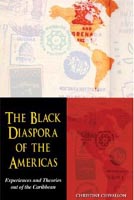 The forced migration of Africans to the Americas through the transatlantic slave trade created primary centres of settlement in the Caribbean, Brazil and the United States the cornerstones of the New World and the black Americas. However, unlike Brazil and the US, the Caribbean did not (and still does not) have the uniformity of a national framework. Instead, the region presents differing situations and social experiences born of the varying colonial systems from which they were developed. Using the Caribbean experience as the focus, Christine Chivallon examines the transatlantic slave trade and slavery as founding events in the identification of a Black diaspora experience. The exploration is extended to include the United States to exemplify contrasting situations in slavery-based systems and identifies the links between the expressions of culture emanating from the black populations of the New World and the diversity of interpretations of the cultural identities of the Black Americas. Divided into three main parts, The Black Diaspora of the Americas firstly examins the foundation of the Black experiences of the New World by considering the slave trade. The second part takes a more theoretical examination of Black diaspora using Rastafarianism, Garveyism and Pan-Africanism while referencing the work of a range of thinkers including Stuart Hall, Paul Gilroy, Richard Price, Edouard Glissant, Melville Herskovits and Sidney Mintz. The work is concluded in the third part with the proposition of an a-centred community of persons of African descent a culture devoid of centrality. The Black Diaspora of the Americas brings together the key arguments about creolisation and the concept of a Black diaspora and presents an outstanding contribution to understanding the dynamics of diaspora.
The forced migration of Africans to the Americas through the transatlantic slave trade created primary centres of settlement in the Caribbean, Brazil and the United States the cornerstones of the New World and the black Americas. However, unlike Brazil and the US, the Caribbean did not (and still does not) have the uniformity of a national framework. Instead, the region presents differing situations and social experiences born of the varying colonial systems from which they were developed. Using the Caribbean experience as the focus, Christine Chivallon examines the transatlantic slave trade and slavery as founding events in the identification of a Black diaspora experience. The exploration is extended to include the United States to exemplify contrasting situations in slavery-based systems and identifies the links between the expressions of culture emanating from the black populations of the New World and the diversity of interpretations of the cultural identities of the Black Americas. Divided into three main parts, The Black Diaspora of the Americas firstly examins the foundation of the Black experiences of the New World by considering the slave trade. The second part takes a more theoretical examination of Black diaspora using Rastafarianism, Garveyism and Pan-Africanism while referencing the work of a range of thinkers including Stuart Hall, Paul Gilroy, Richard Price, Edouard Glissant, Melville Herskovits and Sidney Mintz. The work is concluded in the third part with the proposition of an a-centred community of persons of African descent a culture devoid of centrality. The Black Diaspora of the Americas brings together the key arguments about creolisation and the concept of a Black diaspora and presents an outstanding contribution to understanding the dynamics of diaspora.
[Return to table of contents]
New Book
Crossing Memories: Slavery and African Diaspora
Edited by Ana Lucia Araujo, Mariana P. Candido and Paul E. Lovejoy
Africa World Press, Paperback
308 pp., ISBN-13: 978-1592218202, 2011.
Description from the Publisher:
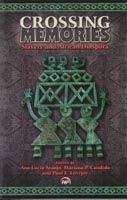 This volume examines the history and the memory of slavery in Africa and the Americas from the period of the transatlantic slave trade until the present day. Using diverse approaches and a myriad of sources, the contributors investigate how slavery has shaped the past and the present lives of African diaspora populations. "Never Again!" should be the slogan of this highly remarkable set of papers as it reminds us of the evils of the trans-Atlantic slave trade, and how its past experienced in blood and pain is reinterpreted, reconstructed and reinvented in multiple spaces and in different eras in the Atlantic world. The crafting is a rich embroidery of scholastic and creative threads, represented by music and dance, poetry and stories, histories and monuments, all combined to produce a colorful garment of stunning beauty. -- Toyin Falola, the Ibn Khaldun Distinguished Research Prefessor, and the Julius Nyerere Mwalimu Chair of Modern African History, Benue State University, Nigeria.
This volume examines the history and the memory of slavery in Africa and the Americas from the period of the transatlantic slave trade until the present day. Using diverse approaches and a myriad of sources, the contributors investigate how slavery has shaped the past and the present lives of African diaspora populations. "Never Again!" should be the slogan of this highly remarkable set of papers as it reminds us of the evils of the trans-Atlantic slave trade, and how its past experienced in blood and pain is reinterpreted, reconstructed and reinvented in multiple spaces and in different eras in the Atlantic world. The crafting is a rich embroidery of scholastic and creative threads, represented by music and dance, poetry and stories, histories and monuments, all combined to produce a colorful garment of stunning beauty. -- Toyin Falola, the Ibn Khaldun Distinguished Research Prefessor, and the Julius Nyerere Mwalimu Chair of Modern African History, Benue State University, Nigeria.
[Return to table of contents]
New Book
Inventing Africa: History, Archaeology and Ideas
By Robin Derricourt
Pluto Press, Paperback
256 pp., ISBN-13: 97-80745331058, 2011.
Description from the Publisher:
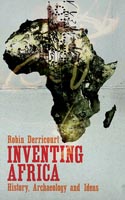 Inventing Africa is a critical account of narratives which have selectively interpreted and misinterpreted the continent's deep past. Writers have created alluring images of lost cities, vast prehistoric migrations and golden ages of past civilisations. Debates continue on the African origins of humankind, the contributions of ancient Egypt to the world and Africa's importance to global history. Images of 'Africa,' simplifying a complex and diverse continent, have existed from ancient Mediterranean worlds, slave trading nations and colonial powers to today's political elites, ecotourists and aid-givers. Robin Derricourt draws on his background as publisher and practitioner in archaeology and history to explore the limits and the dangers of simplifications, arguing -- as with Said's concept of 'Orientalism' -- that ambitious ideas can delude or oppress as well as inform. Defending Africa against some of the grand narratives that have been imposed upon its peoples, Inventing Africa will spark new debates in the history of Africa and of archaeology.
Inventing Africa is a critical account of narratives which have selectively interpreted and misinterpreted the continent's deep past. Writers have created alluring images of lost cities, vast prehistoric migrations and golden ages of past civilisations. Debates continue on the African origins of humankind, the contributions of ancient Egypt to the world and Africa's importance to global history. Images of 'Africa,' simplifying a complex and diverse continent, have existed from ancient Mediterranean worlds, slave trading nations and colonial powers to today's political elites, ecotourists and aid-givers. Robin Derricourt draws on his background as publisher and practitioner in archaeology and history to explore the limits and the dangers of simplifications, arguing -- as with Said's concept of 'Orientalism' -- that ambitious ideas can delude or oppress as well as inform. Defending Africa against some of the grand narratives that have been imposed upon its peoples, Inventing Africa will spark new debates in the history of Africa and of archaeology.
[Return to table of contents]
New Film
Searching for Buxton
Communications Research Institute
William Penn University.
Description from the Producer:
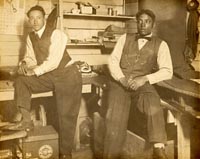 The Communications Research Institute (CRI) at William Penn University has produced a half-hour television program entitled Searching for Buxton. The show is co-produced by Jacob Rosdail and Jason Madison. Jason, an African American young man, goes "searching for Buxton" starting with his grandmother and great aunt (now 95) who were born in Buxton and spent their early years there. The show includes data from the archaeological investigations at the Buxton townsite, archival and oral historical information, and interviews with Buxton descendants. The documentary deals not only with knowledge of the past but also the implications, both positive and negative, of race relations and personal identities today. The show has been airing on Iowa Public Television and other PBS stations. It can be accessed at: http://www.criwmpennu.org (follow the "Searching For Buxton" button on the left). For further information on Buxton's history, see Exploring Buried Buxton: Archaeology of an Abandoned Iowa Coal Mining Town with a Large Black Population, by David M. Gradwohl and Nancy M. Osborn, Iowa State University Press, Ames, 1984.
The Communications Research Institute (CRI) at William Penn University has produced a half-hour television program entitled Searching for Buxton. The show is co-produced by Jacob Rosdail and Jason Madison. Jason, an African American young man, goes "searching for Buxton" starting with his grandmother and great aunt (now 95) who were born in Buxton and spent their early years there. The show includes data from the archaeological investigations at the Buxton townsite, archival and oral historical information, and interviews with Buxton descendants. The documentary deals not only with knowledge of the past but also the implications, both positive and negative, of race relations and personal identities today. The show has been airing on Iowa Public Television and other PBS stations. It can be accessed at: http://www.criwmpennu.org (follow the "Searching For Buxton" button on the left). For further information on Buxton's history, see Exploring Buried Buxton: Archaeology of an Abandoned Iowa Coal Mining Town with a Large Black Population, by David M. Gradwohl and Nancy M. Osborn, Iowa State University Press, Ames, 1984.
[Return to table of contents]
Preservation Conference
South Carolina Department of Archives and History, March 31 to April 1, 2011
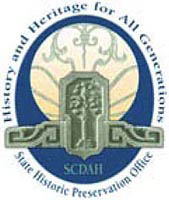 The South Carolina Department of Archives and History's Preservation Conference, March 31 to April 1 includes workshops such as Archaeologists and Archivists Working Together, Unique Preservation Stories from Rural SC, and Running an effective public meeting. The workshop, Archaeologists and Archivists Working Together: Digging into South Carolina's Past, may be of particular interest. The popular perception of archaeologists includes excavations. Yet aside from examining material culture, for historical archaeologists, documents, such as birth and death records, census records, family trees, wills, probate inventories, newspaper articles, diaries, maps, and photographs, can provide additional information for understanding the past. The documents located in the archives help to identify the people who once lived at a particular site, provide the social-cultural context in which the sites were occupied, and contribute to the social meanings of the landscape and the objects recovered. The workshop has three parts: (1) Documentary Archaeology: How do archaeologists use documents and primary sources? (2) Archives Basics: What are archives? What's available? What sorts of documents are useful for archaeological research? (3) Case Studies: Archaeologists discuss how they use primary sources in their archaeological research. This workshop is for practicing archaeologists, students of archaeology, or people who want to think like archaeologists. It is also for archivists, students of library science, or people who are interested in documents and maps. Participants: Jodi Barnes, Archaeologist, SC Department of Archives and History; Brian Cuthrell, Archivist, South Caroliniana Library, University of South Carolina; Craig Keeney, Archivist, South Caroliniana Library, University of South Carolina; Charles Lesser, Archivist, SC Department of Archives and History; Steve Smith, Archaeologist, Applied Research Division, SC Institute of Archaeology and Anthropology; Carl Steen, Archaeologist, Diachronic Research Foundation. For more information contact Jodi Barnes, jbarnes@scdah.state.sc.us. The program can be found at: http://shpo.sc.gov/conf/landpconference/preservationconference.htm.
The South Carolina Department of Archives and History's Preservation Conference, March 31 to April 1 includes workshops such as Archaeologists and Archivists Working Together, Unique Preservation Stories from Rural SC, and Running an effective public meeting. The workshop, Archaeologists and Archivists Working Together: Digging into South Carolina's Past, may be of particular interest. The popular perception of archaeologists includes excavations. Yet aside from examining material culture, for historical archaeologists, documents, such as birth and death records, census records, family trees, wills, probate inventories, newspaper articles, diaries, maps, and photographs, can provide additional information for understanding the past. The documents located in the archives help to identify the people who once lived at a particular site, provide the social-cultural context in which the sites were occupied, and contribute to the social meanings of the landscape and the objects recovered. The workshop has three parts: (1) Documentary Archaeology: How do archaeologists use documents and primary sources? (2) Archives Basics: What are archives? What's available? What sorts of documents are useful for archaeological research? (3) Case Studies: Archaeologists discuss how they use primary sources in their archaeological research. This workshop is for practicing archaeologists, students of archaeology, or people who want to think like archaeologists. It is also for archivists, students of library science, or people who are interested in documents and maps. Participants: Jodi Barnes, Archaeologist, SC Department of Archives and History; Brian Cuthrell, Archivist, South Caroliniana Library, University of South Carolina; Craig Keeney, Archivist, South Caroliniana Library, University of South Carolina; Charles Lesser, Archivist, SC Department of Archives and History; Steve Smith, Archaeologist, Applied Research Division, SC Institute of Archaeology and Anthropology; Carl Steen, Archaeologist, Diachronic Research Foundation. For more information contact Jodi Barnes, jbarnes@scdah.state.sc.us. The program can be found at: http://shpo.sc.gov/conf/landpconference/preservationconference.htm.
[Return to table of contents]
Collective Memory: The Voices of
Remembering and the Silences of Forgetting
San Francisco, California, April 4, 2011
 "To be a member of any human community," wrote the venerated historian Eric Hobsbawm, "is to situate oneself with regard to one's [its] past." In this somewhat disjointed statement, Hobsbawm seems to suggest that individuals, and the communities in which they reside, come together as singular units under an overarching 'past' that informs the essence of an internally exclusive, yet mutually constituted social identity. From this perspective, the 'community' itself contains a 'past' that is, for all intents and purposes, knowable, and in order for individuals to become active participants in their respective communities they must orient their consciousness to some objective notion of the past. Implicit within Hobsbawm's statement is the idea that the 'past' is somehow formalized -- that is, people actively remember the past while simultaneously orienting themselves to the institutionalized and symbolic structures that bind the 'community' together. Building this collective consciousness often requires memorializing the particular people and events that ostensibly constructed present social conditions. A 'sense' of collective memory, therefore, appears in both formal and abstract phenomenon, ultimately providing political, economic, and cultural institutions with legitimacy while also containing the spread of dissent. Yet social and technological innovations have often disrupted the delicate balances that stabilized the borders of these re-collected collective memories. In these circumstances, continuity becomes the enemy of change. The formal structures of institutional memory are frequently abandoned and altogether silenced by new regimes that seek to redefine the social order. A new pattern of orientation emerges out of these changes and the necessary condition of situating 'oneself with regard' to a collective 'past' is slightly transformed, but what remains the same is the codependent relationship between the production and distribution of memory and its ability to influence the contours of history (historical change).
"To be a member of any human community," wrote the venerated historian Eric Hobsbawm, "is to situate oneself with regard to one's [its] past." In this somewhat disjointed statement, Hobsbawm seems to suggest that individuals, and the communities in which they reside, come together as singular units under an overarching 'past' that informs the essence of an internally exclusive, yet mutually constituted social identity. From this perspective, the 'community' itself contains a 'past' that is, for all intents and purposes, knowable, and in order for individuals to become active participants in their respective communities they must orient their consciousness to some objective notion of the past. Implicit within Hobsbawm's statement is the idea that the 'past' is somehow formalized -- that is, people actively remember the past while simultaneously orienting themselves to the institutionalized and symbolic structures that bind the 'community' together. Building this collective consciousness often requires memorializing the particular people and events that ostensibly constructed present social conditions. A 'sense' of collective memory, therefore, appears in both formal and abstract phenomenon, ultimately providing political, economic, and cultural institutions with legitimacy while also containing the spread of dissent. Yet social and technological innovations have often disrupted the delicate balances that stabilized the borders of these re-collected collective memories. In these circumstances, continuity becomes the enemy of change. The formal structures of institutional memory are frequently abandoned and altogether silenced by new regimes that seek to redefine the social order. A new pattern of orientation emerges out of these changes and the necessary condition of situating 'oneself with regard' to a collective 'past' is slightly transformed, but what remains the same is the codependent relationship between the production and distribution of memory and its ability to influence the contours of history (historical change).
The primary goal of the History Students Association's upcoming conference on collective memory is to facilitate a discussion that explores the ongoing production of collective memory and the historical contingencies that influence the manner by which it is organized and allocated. The questions guiding our conversation will not only emphasize the processes and systems that bring about the idea of a unified past, but will also take into consideration the notion that individual and collective consciousness operate both within and outside of these formalized and often prefabricated frameworks. As such, our interests are not limited to understanding the political and economic issues surrounding the idea of collective memory, but also include the discontinuities and silences that often characterize the construction and circulation of memory across space and time. By taking this broad approach to examining the form, function, and content of collective memory and its impact on historical change, we hope to touch on a wide array of topics spanning national and cultural borders, thereby giving participants the opportunity to engage with all facets of this rich and informative topic of academic inquiry. Brian Griffith (HSA President), San Francisco State University, 1600 Holloway Ave., San Francisco, CA 94132, Phone: (415) 236-0HSA (0472), E-mail: hsa@mail.sfsu.edu, griffitb@mail.sfsu.edu, visit the website at http://userwww.sfsu.edu/~hsa/activities/collective_memory_conference/
[Return to table of contents]
Brown-Harvard Conference
on Slavery and Capitalism
Providence and Cambridge, April 7-9, 2011
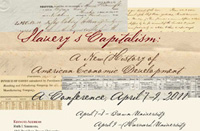 This conference is intended to explore the centrality of slavery to national economic development in the decades between the American Revolution and the Civil War. Presentations will explore New England investment in the plantation economies of the Caribbean; the technological and managerial innovations in plantation management that coincided with northern industrialization; and the origins of modern finance and credit in the buying and selling of enslaved men and women and the crops they produced. This new research suggests that the hotbeds of American entrepreneurship, speculation, and innovation might as readily be found in Mississippi or Virginia as in New York or Massachusetts. The issue is not whether slavery was or was not capitalist (an older debate), but rather the impossibility of understanding the nation's spectacular pattern of economic development without situating slavery front and center.
This conference is intended to explore the centrality of slavery to national economic development in the decades between the American Revolution and the Civil War. Presentations will explore New England investment in the plantation economies of the Caribbean; the technological and managerial innovations in plantation management that coincided with northern industrialization; and the origins of modern finance and credit in the buying and selling of enslaved men and women and the crops they produced. This new research suggests that the hotbeds of American entrepreneurship, speculation, and innovation might as readily be found in Mississippi or Virginia as in New York or Massachusetts. The issue is not whether slavery was or was not capitalist (an older debate), but rather the impossibility of understanding the nation's spectacular pattern of economic development without situating slavery front and center.
The conference begins on Thursday, April 7th, with a keynote address by President Ruth Simmons of Brown University. Paper presentations will follow on Friday the 8th at Brown University. The conference then moves to Harvard for additional papers on Saturday, April 9th. This event is free and open to the public. All the information (including the program and registration form) is here: http://brown.edu/web/slaveryconf/.
[Return to table of contents]
Race/Ethnicity: Multidisciplinary Global Contexts
Call for Papers, May 15, 2011
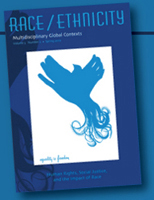 Guest editor David Anderson Hooker, Director of Research and Training for Coming to the Table: Taking America (USA) Beyond the Legacy of Enslavement, and the editorial staff of Race/Ethnicity: Multidisciplinary Global Contexts, invite submissions for the first issue of its fifth volume, entitled "500 Years Later: Reverberations of the Translatlantic Slave Trade." The Transatlantic Slave Trade most immediately touched societies and lives in France, Great Britain, Portugal and Brazil, the Netherlands, North America, the Caribbean, West Africa and Central Africa. We especially welcome analyses, critiques, reflections, and documentation by activists, community-based organizations, and others living and working in these countries and regions or working on issues that implicate developments and dynamics in these places. Of course, the work of scholars, advocates, activists and practitioners in all disciplines working elsewhere are also welcome. The mission of the journal is to expand current conversations on race and ethnicity by working across geographical and disciplinary boundaries and the theory/practice divide. Visit the journal's website at http://www.raceethnicity.org.
Guest editor David Anderson Hooker, Director of Research and Training for Coming to the Table: Taking America (USA) Beyond the Legacy of Enslavement, and the editorial staff of Race/Ethnicity: Multidisciplinary Global Contexts, invite submissions for the first issue of its fifth volume, entitled "500 Years Later: Reverberations of the Translatlantic Slave Trade." The Transatlantic Slave Trade most immediately touched societies and lives in France, Great Britain, Portugal and Brazil, the Netherlands, North America, the Caribbean, West Africa and Central Africa. We especially welcome analyses, critiques, reflections, and documentation by activists, community-based organizations, and others living and working in these countries and regions or working on issues that implicate developments and dynamics in these places. Of course, the work of scholars, advocates, activists and practitioners in all disciplines working elsewhere are also welcome. The mission of the journal is to expand current conversations on race and ethnicity by working across geographical and disciplinary boundaries and the theory/practice divide. Visit the journal's website at http://www.raceethnicity.org.
[Return to table of contents]
Remembering Slavery, Forgetting Indenture?
Bangor University, UK, September 9-10, 2011
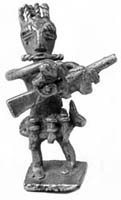 Bangor University, UK, in conjunction with the Centre for the Study of International Slavery in Liverpool. 2011 marks the ten-year anniversary of the French Taubira law of 21 May 2001, which recognized the slave trade and slavery perpetrated in the Americas, the Caribbean, the Indian Ocean and Europe as a crime against humanity. This key date provides an opportunity to examine responses to memories of slavery which have emerged in France and internationally over the past decade. It enables us to reflect upon the recent substantial body of research that has been conducted into the cultural processes of remembering and representing slavery and the slave trade. Importantly, however, it also leads us to question whether this 'memory law' has opened up a space in which to explore memories of other, interconnected forms of colonial exploitation, such as indentured and forced labour. Has the emphasis on the need to defend the memory of the enslaved equated to a failure to recognize other forms of colonial and post-slavery exploitation?
Bangor University, UK, in conjunction with the Centre for the Study of International Slavery in Liverpool. 2011 marks the ten-year anniversary of the French Taubira law of 21 May 2001, which recognized the slave trade and slavery perpetrated in the Americas, the Caribbean, the Indian Ocean and Europe as a crime against humanity. This key date provides an opportunity to examine responses to memories of slavery which have emerged in France and internationally over the past decade. It enables us to reflect upon the recent substantial body of research that has been conducted into the cultural processes of remembering and representing slavery and the slave trade. Importantly, however, it also leads us to question whether this 'memory law' has opened up a space in which to explore memories of other, interconnected forms of colonial exploitation, such as indentured and forced labour. Has the emphasis on the need to defend the memory of the enslaved equated to a failure to recognize other forms of colonial and post-slavery exploitation?
The focus of this two-day conference will be on comparing the continuities and discontinuities between the ways in which slavery, indenture and forced labour have been remembered, narrativized and commemorated. It will bring into dialogue academics working on memories of slavery with those working on memories of indentured and forced labour systems, particularly in France and the former French colonies, but also extending to other global contexts. Confirmed keynote speakers are Dr Françoise Vergès (Goldsmiths, University of London), head of the Committee for the Memory and History of Slavery in France, and Professor Charles Forsdick, James Barrow Professor of French at the University of Liverpool. Taking a comparative, interdisciplinary approach, the conference will call into question the chronological and semantic divides between slavery and indenture by fostering debate around key questions, such as: Historical and contemporary definitions of slavery and forms of enslavement, indenture and forced labour: where to draw the lines? Processes of remembering, forgetting, commemorating and memorializing that have shaped representations of slavery, indenture and forced labour (in historiography, museums, literature, film, etc.). France's 'memory wars': colonialism, slavery and the problem of the devoir de mémoire. Constructing identities and cultural memories of slavery and indentured labour in the twentieth and twenty-first centuries (for example, literary and political movements such as négritude, créolité, coolitude). Ongoing economic, cultural, social and political effects of slavery, indenture and forced labour in former colonial contexts. Individual papers should be no longer than 20 minutes. Please send a 250-300 word abstract and a brief biography to Nicola Frith (n.frith@bangor.ac.uk) or Kate Hodgson (K.Hodgson@liverpool.ac.uk) by 29 April 2011.
[Return to table of contents]
96th Annual ASALH Conference
African Americans and the Civil War
Richmond, Virginia, October 5-9, 2011
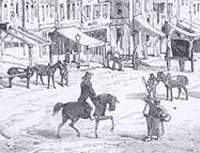 The Association for the Study of African American Life and History (ASALH) is soliciting papers and panels for its upcoming 96th Annual Convention. This year's conference theme is: "African Americans and the U.S. Civil War." Although the program committee welcomes papers and panels on any aspect of African and African American history and culture, special preference will be given to submissions directly related to this year's theme. Using a wide variety of disciplines, this year's conference seeks to explore many aspects of African American involvement in the Civil War, 1861-1865. Important topics include African Americans and the abolitionist movement, African American women and life on the homefront during the war years, African American participation in the military, and African American life and politics during the Reconstruction Era, 1865-1877. In addition, recent popular and scholarly debates over causes of the Civil War will be explored.
The Association for the Study of African American Life and History (ASALH) is soliciting papers and panels for its upcoming 96th Annual Convention. This year's conference theme is: "African Americans and the U.S. Civil War." Although the program committee welcomes papers and panels on any aspect of African and African American history and culture, special preference will be given to submissions directly related to this year's theme. Using a wide variety of disciplines, this year's conference seeks to explore many aspects of African American involvement in the Civil War, 1861-1865. Important topics include African Americans and the abolitionist movement, African American women and life on the homefront during the war years, African American participation in the military, and African American life and politics during the Reconstruction Era, 1865-1877. In addition, recent popular and scholarly debates over causes of the Civil War will be explored.
In 1861 as the United States stood at the brink of civil war, people of African descent, both slave and free, waited with a watchful eye. They understood that a war between the Union military and the Confederacy might bring about the "day of jubilee" and the destruction of slavery. When the Confederate troops fired upon Fort Sumter on 12 April 1861 and hostilities began, President Abraham Lincoln maintained that the paramount cause was to preserve the Union, not to end the practice of slavery. Frederick Douglass, the most prominent African American leader, declared that regardless of Union intentions, the war would bring an end to the South's "peculiar institution." Over the next four years, the four million people of African descent in the United States sought to prove Frederick Douglass right. Free and enslaved African Americans rallied around the Union flag and the cause of freedom. From the cotton and tobacco fields of the South to the small towns and big cities of the North, nearly 200,000 black men joined the Grand Army of the Republic and took up arms to destroy slavery and the Confederacy. The ASALH convention theme for 2011 honors the role of people of African descent in ending slavery and preserving the Union. Given the recent political and academic debates about the legacy of the Civil War, papers and panels offering interdisciplinary analyses and perspectives of the continuing legacy of the Civil War in American and African American life are particularly welcome.
The deadline for the submission of panel and paper proposals is 30 April 2011. All proposals must be submitted electronically to ASALH through the All Academic online system at http://www.asalh.org/callforpapers.html. For complete panels that are submitted by March 30, day and time preferences will be given on a first come, first served basis. Please refer to the FAQ page for what constitutes a complete panel at http://www.asalh.org/files/FAQs_sheet.doc. Proposals should include title of the paper or panel, author(s) and affiliation(s), an abstract of paper or panel of 200-250 words, and all contact information. Only panel proposal submitters will receive complimentary audio/visual equipment on a first come first serve basis. For information on how to make electronic submissions, please visit www.asalh.org/96thconvention.html and visit the FAQ page at http://www.asalh.org/files/FAQs_sheet.doc for important information regarding submissions.
Derrick P. Alridge, Academic Program Chair, dalridge@uga.edu
[Return to table of contents]
Association for the Study
of the Worldwide African Diaspora
University of Pittsburgh, Pennsylvania, November 3-6, 2011
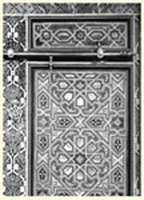 You are invited to participate in the Sixth Biennial conference of the Association for the Study of the Worldwide African Diaspora (ASWAD), to be held November 3-6, 2011. Conference Theme: African Liberation and Black Power: The Challeneges of Diasproic Encounters Across Time, Space, and Imagination. In 1954, novelist and intellectual Richard Wright published Black Power, a provocative book in which Wright offered his reflections on his travels to the Gold Coast as it was in the process of becoming the independent nation of Ghana. The term "Black Power" that Wright used to signify the possibilities of freedom and development for Africans, as well as Pan-African cultural connections, would become a familiar notion to people of African descent around the world, who identified with its potent message for liberation and cultural revitalization. In so doing, Wright opened a new chapter in the long history of political and intellectual dialogue across the African Diaspora-one that revealed both the convergences and ruptures between people of African descent on the continent and in Diaspora.
You are invited to participate in the Sixth Biennial conference of the Association for the Study of the Worldwide African Diaspora (ASWAD), to be held November 3-6, 2011. Conference Theme: African Liberation and Black Power: The Challeneges of Diasproic Encounters Across Time, Space, and Imagination. In 1954, novelist and intellectual Richard Wright published Black Power, a provocative book in which Wright offered his reflections on his travels to the Gold Coast as it was in the process of becoming the independent nation of Ghana. The term "Black Power" that Wright used to signify the possibilities of freedom and development for Africans, as well as Pan-African cultural connections, would become a familiar notion to people of African descent around the world, who identified with its potent message for liberation and cultural revitalization. In so doing, Wright opened a new chapter in the long history of political and intellectual dialogue across the African Diaspora-one that revealed both the convergences and ruptures between people of African descent on the continent and in Diaspora.
For its sixth biennial conference, to be held in Pittsburgh, ASWAD explores the theme "African Liberation and Black Power: The Challenges of Diasporic Encounters Across Time, Space and Imagination." This conference intends to appreciate the Diasporic dimensions and articulations of Black Power, with special emphasis on Africa, Europe, the Caribbean, Latin America, and Asia by tracing the genealogies of the concept and challenging localized limitations of Black Power scholarship. Though the term "Black Power" is most frequently associated with the political and cultural movement of the 1960s and 1970s in the United States, the drive to valorize blackness and Africanity/Africanité was broadly shared throughout Africa and the African Diaspora. Black Power was a transnational phenomenon; in addition to the U.S., organizations, activists, artists, and politicians in Canada, Trinidad, Guyana, Jamaica, Bermuda, UK, South Africa, Zaire, and elsewhere explicitly identified themselves as adhering to Black Power. Each of these local movements responded in unique ways, but remained in dialogue with peoples of African descent and other peoples seeking creative responses to oppressive regimes. At the same time, 1970s black feminist organizations such as the Combahee River Collective (USA) and the Southall Black Sisters (UK), as well as writers such as Claudia Jones, Audre Lorde and Bessie Head, openly contested the masculinist, heteronormative tendencies within Black Power. Indeed, Diasporic feminists often imagined freedom in far more expansive political and aesthetic terms than their male counterparts.
In exploring Black Power as a global phenomenon, ASWAD encourages the submission of papers that interrogate the elements that define Black Power, its multiple locations, and articulations, its gendered and sexual contours, the transnational connections that informed and nurtured it as well as global and local cultural and political projects that revitalize it in the twenty-first century. In addition, we seek to identify the antecedents of Black Power, and historicize it within the trajectories of African and African Diasporic literature, culture, media, philosophy, politics, and the academy itself, as well as its relationship to health and environmental issues. The cultural and ideological foundations of Black Power had deep roots in the 17th, 18th, and 19th centuries and, as such, ASWAD encourages papers that excavate the origins of the cultural, intellectual, and political expressions that gave birth to the liberation struggles of the 20th century. All geographic areas will be represented, including Africa, the Americas, the Middle East, Europe, and Asia. Paper and panel proposals that incorporate women, gender, and sexuality as categories of analysis are encouraged.
Proposals: Please send a two-page abstract (for either a single presentation or a panel) and a one-page CV (or multiple one-page CV's) by MAY 15, 2011. They can be sent prior to submitting the registration fee, and are to be sent electronically via email attachment to: aswad2011@osu.edu. Other queries (but not abstracts; please send all abstracts to same email address) can be addressed to: Leslie M. Alexander, Conference Co-Chair, Associate Professor, 371 Dulles Hall, 230 West 17th Avenue, Department of History, The Ohio State University, Columbus, OH 43210. We intend to post papers on our website, and some may be selected for publication. If you do not wish your paper to appear in either format, please clearly indicate such. Completed materials should be submitted in publishable form prior to the first week in October, 2011.
[Return to table of contents]
Book Review
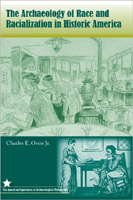
Charles Orser Jr. The Archaeology of Race and Racialization in Historic America. Tallahassee, University Press of Florida, 2007, 232 pp., $25.00 (paperback), ISBN 978-0-813-03143-9.
Reviewed for the African Diaspora Archeology Newsletter by Diane E. Wallman, University of South Carolina
Charles Orser has remained at the forefront of discussions of race in historical archaeology, and continues on this path in his latest book The Archaeology of Race and Racialization in Historic America. In this publication, Orser aims to bring the topic of race, and more specifically the process of racialization, to the center of the historical archaeology agenda in America. He argues for a specific framework guiding how archaeologists approach race, suggesting that we look at racialization as a structural process that has explicit connections to relations of power and control. Archaeologists must not only address this process in the past, but also engage with this structure as it continues to shape our experiences.
Historical archaeologists, in Orser's view, should explicitly engage in identifying and revealing how the process of racialization is materialized. In order to take on this role, it is necessary that we approach racialization through a structural framework, as opposed to a cognitive perspective. From this standpoint, racialization and racism "create action and encourage practice within a carefully constructed system of power relations" (p. 13). In order to "confront and engage" this process, he advocates for archaeologists to investigate the possible connections between capitalism, material consumption and racialization.
According to Orser, anthropology and race have a long interconnected history, but archaeologists lagged behind other social scientists in explicitly addressing racialization within their research. Recent research in historical archaeology, however, has focused on race and identity, the spatiality of race, and the development of race relations. Orser argues that those studies that have investigated race have largely focused on the history of African Americans, paying little attention to the construction of whiteness in America, and to racialization as it occurred beyond the Eastern Coast of the United States. Additionally, he endorses community involvement and reflexivity in order to deconstruct the race structure that persists today.
Throughout the first three chapters, Orser develops an explicit multi-scalar framework through which archaeologists can develop a more thorough and sophisticated understanding of the structure of racialized relations within America and how this structure was negotiated locally. In order to address race as an aspect of "epochal structure," according to Orser, it is necessary to deconstruct how racism was historically constructed within the American social system. Orser argues that racialization in America is directly connected to the "hierarchical structure of capitalist society" (p. 51). Epochal structures, in Orser's view, include "societal structures of inequality" (p.53) which are constructed of network relations, and these relations are enacted or performed in particular spaces and places. It is up to archaeologists, then, to investigate how places and materials reveal relations within the epochal structure.
Orser bases this 'model' on Bourdieu's conceptions of habitus, capital and fields. He sees the racial category as a kind of "embodied cultural capital," (p. 60) in that race becomes naturalized through becoming a part of ones habitus. In order to examine the process of racialization in the material record, archaeologists need to view consumption as occurring within a network of social relations. People will manipulate networks of relations through consumption within the structural constraints of their habitus. Our ultimate goal as historical archaeologists is to "discover ways to observe racialized differences in material culture generated during capitalism" (p. 69).
To demonstrate his approach to historic racialization in America, Orser presents two case studies. The first is an exploration of the Irish in New York, and the second focuses on the Chinese in California. Through these examples, he argues that racialization was not simply constructed on phenotype, but as exemplified by the categorization of the Irish as 'non-white,' incorporated factors such as educational rank and occupation.
Orser first focuses on the Irish in New York City, providing historical, documentary and archaeological evidence to investigate racialization in this context. In order to contextualize the archaeological study of an Irish Tenement in New York's Five Points neighborhood, Orser presents the historical evidence revealing the habitus of the immigrants from Ireland and also the epochal structures in place within the U.S. during the mid-late 19th Century. These epochal structures, according to Orser, were both social and politico-legal, involving the actions of social networks in developing anti-Immigrant sentiment and also the construction of laws and statutes to constrict the immigrants. The racialization of the Irish, according to Orser, began in Ireland, but was 'perfected' through the nativist movements in the United States. Using pictorial images and 19th century 'scientific' inquiry, Orser demonstrates how anti-Irish racialization was a part of habitus formation for non-Irish Americans. The racialization of the Irish in New York was most clearly materialized through the spatial segregation of the community within the city. Orser suggests that archaeological evidence, medicinal bottles in this context, should reveal this spatial segregation and the epochal racial structure that existed in America.
In chapter five, Orser uses both historical records and archaeology to present a case study in which he focuses on the process of racialization in the late nineteenth and early twentieth centuries in California. Orser analyzes the materials recovered from the excavation of a Chinese laundry in Stockton, California to address how the national pursuit of the racialization of the Chinese in the United States is revealed through the material record. The bulk of this case study addresses the larger issue of Chinese racialization in America, which took place mostly in the late nineteenth and early twentieth centuries throughout the United States. Orser (p. 139) presents a variety of sources to show the "racialist habitus of the United States" during Chinese socialization, including pamphlets and books, United States Federal Acts and Treaties, and political cartoons. Orser then provides an overview of the negative treatment of Chinese laundries and launders in America, and reviews the findings of previous ethnographic/historic studies, including that of a Chinese community in Oakland, and one of the Chinese in Chicago. Finally, Orser provides a brief analysis of the material record from the Stockton site.
Within these case studies, Orser argues that racialization is a process in which individuals who are "collectively classified as white maintained control and authority over people perceived as nonwhite," but that it is also highly situational and negotiated on a local-scale. His detailed discussion of the history of these two groups, as well as his attention to institutionalized and structural racism as it developed in the United States is a unique contribution to the discipline, revealing the insight that historical archaeology can give towards understanding the nuances the immigrant experience.
Overall, this book provides a very useful vocabulary and framework through which historical archaeologists can discuss and investigate issues of race and racialization. This publication provides a 'call to action' for historical archaeologists to develop a more sophisticated and explicit discussion of race. While many of the ideas presented in this book are not novel concepts, as illustrated by Orser's own review of the historical archaeology of race and racialization, this discussion brings to light the surprising deficiency in attention to this topic in much of historical archaeology that persists even today. In particular, within the archaeology of the African Diaspora, it seems that the process of racialization is often a contextual observation rather than an explicit focus of investigation.
As Orser and others have pointed out, the racialized structure of the colonial and industrial world was developed as the institution of slavery progressed. Forming social relations around skin color and other phenotypic traits was a shift often associated with the rise of capitalist endeavors in the New World and associated economic benefits of slavery in the colonies. Institutionalized and structural racism was a situational and fluctuating process that developed over time to allow for the development and maintenance of power and control by the 'dominant' group. As archaeologists we are in a unique position to examine process of racialization associated with Africans and African Americans in the New World, through the material record, as it developed over time and across space. As much of our research takes place within local, small-scale contexts, we are also able to focus on the more particular expressions of this structure, as individuals and groups negotiated and resisted the epochal structures in place in historic America. Orser has provided a highly useful framework through which archaeologists of the African Diaspora can begin to more comprehensively address race as a central concern of our research, as it is materialized in the archaeological record.
[Return to table of contents]
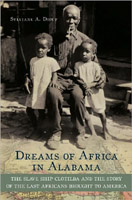
H-NET BOOK REVIEW
Published by H-CivWar, http://www.h-net.org/~civwar/ (Jan. 2011).
Sylviane A. Diouf. Dreams of Africa in Alabama: The Slave Ship Clotilda and the Story of the Last Africans Brought to America. New York: Oxford University Press, 2009. 352 pp. $19.95 (paper), ISBN 978-0-19-538293-8.
Reviewed for H-CivWar by Oleta Prinsloo, Miami University
The Slave Ship Clotilda
Sylviane A. Diouf has written an excellent social history of the Clotilda and the West Africans who were purchased at Dahomey and illegally transported on the ship to Alabama in the summer of 1860. This voyage occurred more than fifty years after the Constitution prohibited American involvement in the transatlantic slave trade. Diouf's first task is to convince readers that the Clotilda Africans in fact existed. This is necessary because, from the Buchanan presidency to Hugh Thomas's recent The Slave Trade (1999), official investigations and historians have denied the existence of the voyage and the 110 Africans brought to Alabama. Before Diouf's book, most historians believed that the Wanderer, making a trip to West Africa two years earlier in 1858, was the last American slaving passage. To prove the existence of the Clotilda voyage, Diouf identifies individual Africans and locates their African communities of origin. She then presents histories of the Dahomey Kingdom and its hinterland to demonstrate that particular Africans could have been captured only from certain areas after the Wanderer's crossing. The result is a more complete picture of the process of transatlantic slavery and experiences and cultures of the people involved. By reconstructing specific African cultures and religions of enslaved persons, she demonstrates how these cultures helped sustain enslaved people during antebellum slavery and the transition from slavery to freedom after the Civil War.
More than twelve million Africans were forced to make the Middle Passage, but historians have identified only a few individuals and their African backgrounds. Historians accordingly know little about enslaved Africans' cultures of origin and how these cultures shaped their experiences in America. The most well-known account of an enslaved African transported to the Americas is the Narrative of Olaudah Equiano (1789), but recently a scholar has questioned whether Equiano was even born in Africa. Thus Diouf's historical recovery of certain Clotilda Africans is very significant for demonstrating African experiences before enslavement. She argues that it was the Clotilda Africans' cultures and the memories of being free people in Africa that shaped their responses to living in the South as slaves: "Their transition from freedom to servitude and back to freedom highlights the aspects of their cultures that were most useful to them as individuals and as members of a free community" (p. 4).
Another important contribution of the study concerns Africans adapting to life in Alabama after the Civil War and through the first decades of the twentieth century. Diouf documents how the Africans successfully made the transition to freedom and how they maintained their identity as Africans and created their own community during Reconstruction and Jim Crow segregation. In 1870, they established African Town on property that they purchased near Mobile. African Town, Diouf asserts, was the longest lasting black community in America and one that retained its ethnic identity longer than any other. Diouf attributes the success of the Clotilda people to having been free in West Africa.
Diouf bases her account on Alabama and national newspapers that reported on the Clotilda, narratives and interviews of the Clotilda owner and the captain, and interviews of Clotilda Africans and their children. Dreams of Africa is thus one of the few studies of transatlantic slavery that utilizes primary sources from the perspectives of both the slavers and the enslaved. Diouf also relies on writer and folklorist Zora Neal Hurston's unpublished manuscript based on two months of interviews with Cudjo Lewis, the last Clotilda survivor. Other sources include interviews of the Africans conducted by Booker T. Washington and local historians. Diouf places the Africans in the context of the historiography of the Dahomey region (modern Benin and northwest Nigeria), southern historiography, and Mobile history.
Diouf begins the story of the Clotilda people in Mobile by discussing the financial motives for enterprising individuals to engage in the illegal slave trade. Mobile, financially dependent on cotton and thus on slavery, was Alabama's "slave emporium." And Alabama's most lucrative business after plantation slavery was the domestic slave trade. As the center of domestic slavery shifted from the eastern seaboard to the Southwest with the expansion of cotton production, the domestic slave trade could not keep up with the demand for enslaved labor. Diouf also reminds readers that some of the strongest defenders of slavery were born in New England as was the Clotilda's owner, Timothy Meaher from Maine.
To make her case that the Clotilda Africans came after the Wanderer in 1858 and sailed from West Africa in 1860, Diouf describes 1860 as a boom year for slave trading in Dahomey. This was a change from the early 1850s, when Dahomey had signed a treaty agreeing to stop exporting slaves and agreed to only engage in the legitimate trade in palm oil. But palm oil did not bring as much profit to the royal house, and so in 1858, after increasing demand for slave labor in Cuba, King Ghezo resumed the slave trade. After his death in 1858, his son Glele intensified slave raiding into the interior of the Bight of Biafra.
Before enslavement, the Clotilda people were "Muslims and non-Muslims; farmers, traders, and fishermen; victims of kidnapping, raids, and wars" (p. 39). Diouf determines that most of the Africans were Yoruba or Bante from Benin. Bante was a town or market area where women usually sold agricultural products at market, which helps explain why the Clotilda women would become successful traders in Alabama after the Civil War. She makes the determination of origins by placing the Africans' descriptions of architecture, river names, distance traveled to the coast, community defense systems, and secret societies in the context of ethnographies and the new historiography on central African history. Much of her study focuses on the oral histories of Lewis, who gave the most interviews. His account of the enslavement process in Africa is one of only four such narratives by central Africans and is a valuable contribution to the study of African slavery and transatlantic slavery. Diouf's approach to locating the original homes of Africans should become a model for scholars attempting to retrace the social, cultural, and family backgrounds of enslaved Africans.
Diouf examines how the recently arrived Africans were initiated into slavery and how they related to American-born slaves in Alabama. Since African American slaves tended to denigrate the Clotilda people as "African savages," the Africans segregated themselves from other slaves on the basis of their African identity. Upon freedom, the Africans wished to return to their homelands. But as they could not find a way to finance a voyage to Africa, they tried to remain as independent as possible based on their African identity. Therefore, they attempted to recreate their lives as free African people in Alabama. With men earning wages at lumber mills and railroad yards, and women growing and selling produce in the market, they pooled their savings, and, in 1870, purchased land a few miles outside of Mobile that became African Town. Diouf argues that the reason they were able to accomplish economic independence with a degree of self-governing autonomy so soon after freedom was because of their shared African values and ethics: "The African tradition of collectivism was certainly a major part of the reason why shipmates were able to acquire land and housing early" (p. 155).
Once they established African Town, their experiences paralleled those of African Americans during Reconstruction and after. They converted to Christianity in the late 1860s, and, after the passage of the Fourteenth Amendment, they became American citizens, even as they continued to identify themselves as African. But even though they had achieved economic independence, and owned and governed their own community, African American leaders like Booker T. Washington denigrated them for clinging "to the memories and traditions of their savage life in Africa" (p. 181). By the 1930s, with the deaths of all the founding members, African Town lost its African character and become an African American town.
The greatest strength of the book is its broad theme of how West Africa influenced African American history. For this reason, it would have been beneficial to scholars for Diouf to have engaged with studies of African survivals and adaptations by Sterling Stuckey, Margaret Creel Washington, Michael Gomez, and Gwendolyn Midlo Hall. Another minor quibble is that perhaps Diouf could have been more critical of slave raiding in Africa and such practices as ceremonial human sacrifice.
Nevertheless, this is an exceedingly well and creatively researched study that greatly contributes to the fields of slavery and African American history.
Copyright (c) 2011 by H-Net, all rights reserved. H-Net permits the redistribution and reprinting of this work for nonprofit, educational purposes. This work is licensed under a Creative Commons Attribution-Noncommercial-No Derivative Works 3.0 United States License.
[Return to table of contents]
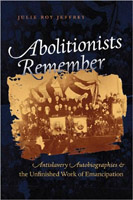
H-NET BOOK REVIEW
Published by H-CivWar, http://www.h-net.org/~civwar/ (Oct. 2010).
Julie Roy Jeffrey. Abolitionists Remember: Antislavery Autobiographies and the Unfinished Work of Emancipation. Chapel Hill: University of North Carolina Press, 2008. xii + 337 pp. $59.95 (cloth), ISBN 978-0-8078-3208-0; $24.95 (paper), ISBN 978-0-8078-5885-1.
Reviewed for H-CivWar by Daniel J. McInerney, Utah State University
Reform through Memory
Julie Roy Jeffrey takes up the study of American abolitionists at the point where many scholars have left off. She focuses on reformers after 1865, examining the ways in which advocates engaged in a renewed debate with a nation inclined to forget, evade, or mythologize the recent past, eager to put sectional quarrels aside, and content to accept a menacing climate of racism in the interests of sectional peace. In the last third of the nineteenth century -- as in the second third -- abolitionists found themselves deeply embroiled in discussions about the experience of human enslavement, the meanings of freedom, the possibilities of equality, and the responsibilities of the Republic. The memoirs abolitionists wrote to engage in this renewed debate represented a double-edged return to the past. Purposefully, the writers presented historical accounts of the antislavery movement's origins. Tragically, reformers retraced earlier ground as a way to confront resurgent racial fears and resentments in their own time that echoed those of the 1830s.
The context for Jeffrey's exceptionally fine study rests in the scholarship on historical memory in the post-Civil War period. Building on works by David Blight (Race and Reunion: The Civil War in American Memory [2001]), W. Fitzhugh Brundage (The Southern Past: A Clash of Race and Memory [2005]), Mitchell A. Kachun (Festivals of Freedom: Memory and Meaning in African American Emancipation Celebrations, 1808-1915 [2003]), Nina Silber (The Romance of Reunion: Northerners and the South, 1865-1900 [1993]), and others, Jeffrey explores how the abolitionists' reading of history contrasted with a "reconciliation" version of the past, one that located the roots of war in abstract and idealistic political ideals rather than the grim calculus of slavery, celebrated the sacrifices of both Union and Confederate armies, romanticized the paternal care masters extended over presumably childlike slaves, and chastised "divisive" advocates of social reform who had brought America to such a bloody impasse. Jeffrey acknowledges that chronicles of bravery, honor, and racial hierarchy eventually prevailed in popular historical consciousness. But she reminds readers that efforts to shape the collective memory of the Civil War began as highly contested debates. Individual reformers and abolition organizations offered a range of autobiographies, institutional histories, short stories, images, and collective rituals that formed a "counternarrative" focused on the horrors of the chattel system, the calculating motivations of secessionists, the oppression of African Americans, the justification of reform, and the powerful forces arrayed against advocates of freedom (p. 21).
Jeffrey examines some twenty-five memoirs by reformers, arranging the works in chronological order and exploring how late nineteenth-century struggles over the meaning and purpose of the Civil War shaped the shifting recollections that advocates held of early nineteenth-century events. The study opens within the institutional base of abolition, examining debates between reformers who believed that Civil War amendments had fulfilled the campaign's goals and those who feared that racial prejudice would leave African Americans at risk of further degradation and dispossession. As antislavery societies ceased operations, reformers were left with little organizational support and turned to ruggedly individual means of continuing moral agitation. Samuel J. May's 1869 autobiography was one of the first efforts, setting the tone for many subsequent works by focusing on the national problem of race prejudice, Southern resistance to constitutional reform, and calls for expanded and strenuous federal intervention on behalf of freed people. Three years later, William Still's book, The Underground Rail Road, offered a potent antidote to racial stereotypes by foregrounding the work of black men and women in their own struggle for self-liberation. Early memoirs such as these commonly stressed the harmony of antislavery efforts and the varied but complementary paths taken on the road to liberation. Reformers' writings took a different direction in the 1880s as abolitionists tended to become more quarrelsome, reviving older debates about the relative merits of politically and morally based approaches to social reform. By the end of the century, however, as the nation witnessed systematic restrictions on black rights and escalating racial violence, the divisive tone of memoirs eased and surviving abolitionists addressed one another on more conciliatory and respectful terms.
Such a sweeping summary fails to do justice to Jeffrey's nuanced and thoughtful reading of antislavery reformers in the late nineteenth century. Her analysis of their memoirs touches on a wide variety of themes, exploring the different roles authors fashioned for themselves in reform activity, their thoughts on the possibility of moral progress in a modern age, and their responses to the historical amnesia they detected in American society. Jeffrey examines abolitionists who reevaluated the role of Abraham Lincoln in the work of emancipation, placed the work of antislavery in a gendered frame of reference, commented on the role of churches in the struggle for emancipation, and debated among themselves over the capacities of the people they had worked to free. In the case of reformers who provided multiple accounts of their abolition experience, Jeffrey explores revisions made in memoirs (as in her discussion of Mary Grew) and the comments advocates made on the historical reflections of their colleagues (in a section on Frederick Douglass).
The richest quality of Jeffrey's work rests in the multiple contexts through which she views her subject. The study deftly examines reformers' memoirs in terms of the personal experiences of advocates who had to deal with their own affairs, their livelihoods, their health, and, in several cases, their own financial sacrifice in order to publish works that would set the record straight on the work of abolition. Jeffrey also examines the writings from a literary perspective, focusing on memoirs as a distinct genre set apart by both critical norms and by popular expectations. In addition, the author examines the business of publication in the late nineteenth century, calling attention to influential periodicals and presses, the contractual arrangements made with authors, and sales figures for the volumes that reformers produced.
Throughout the study, Jeffrey takes a frank and critical view of her subjects. While acknowledging both the abolitionists' bravery (in the face of broader cultural resistance) and their energy (in terms of the endurance of their reform commitments), she recognizes that the memoirs under review seldom displayed literary flair, often revealed self-serving motives, and rarely reached wide audiences. The absence of vigorous abolition organizations after the 1860s weakened even further the reformers' ability to sustain interest and support in their campaigns.
Abolitionists Remember is an engaging and resonant work that suggests how reform communities have often focused their attention on the illumination of the past as a means of guiding the alteration of the future, recognizing recollection as a powerful form of agitation. The memory invoked in the arguments of advocates can commonly clarify, affirm -- and in the abolitionists' case -- compel the altered direction society should take. In this way, reform projects may be viewed as simultaneously retrospective and prospective, grounding the possibility of what might be on a careful recovery of what had been. As they revisited the origins of their reform effort, the subjects of Jeffrey's study stand not only as purposeful chroniclers of the past but also, in a sense, as some of the first "re-enactors" of the period, returning to the ground of their social commitments, retracing the route of their reform engagement, and reaffirming the necessity of their program for social change.
Copyright (c) 2011 by H-Net, all rights reserved. H-Net permits the redistribution and reprinting of this work for nonprofit, educational purposes. This work is licensed under a Creative Commons Attribution-Noncommercial-No Derivative Works 3.0 United States License.
[Return to table of contents]
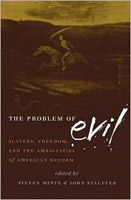
H-NET BOOK REVIEW
Published by H-CivWar, http://www.h-net.org/~civwar/ (Jan. 2011).
Steven Mintz, John Stauffer, eds. The Problem of Evil: Slavery, Freedom, and the Ambiguities of American Reform. Amherst and Boston University of Massachusetts Press, 2007. 405 pp. $24.95 (paper), ISBN 978-1-55849-570-8.
Patrick Rael, ed. African-American Activism before the Civil War: A Reader on the Freedom Struggle in the Antebellum North. New York Routledge, 2008. viii + 307 pp. $125.00 (cloth), ISBN 978-0-415-95726-7; $34.95 (paper), ISBN 978-0-415-95727-4.
Reviewed for H-CivWar by Oleta Prinsloo, Miami University
Reform and Activism in Antebellum America
Two compilations of essays, "The Problem of Evil" and "African-American Activism before the Civil War," have recently been published. The first, edited by Steven Mintz and John Stauffer, two of the leading scholars on American social history and reform, concerns the effects of slavery, racism, economic inequality, and American power on American institutions. Some of the nineteen essays are by scholars who have been defining the historical interpretation of slavery, race, and reform since the 1970s including Orlando Patterson, Ira Berlin, Stanley Engerman, and David Eltis, while others are by well-established and new scholars. Rheinhold Neibhur's work on the relation between religion and evil and David Brion Davis's work on the connections between religion, slavery, antislavery, and capitalism inform many of the essays. (Davis has become more interested in issues of religion and morality in his more recent work.) "The Problem of Evil" is wide-ranging in topic and time span. The first of the nineteen essays is Patterson's summary of his work on the philosophical nature of slavery and freedom in the ancient world and the last essay is Jack Holt's examination of how Dwight D. Eisenhower's faith informed his politics during the Cold War.
Putting together a volume on the implications of evil for the study of American history is a tremendously significant undertaking, especially in post-9/11 America. Contributing to the worthiness of this project are the superb introductory essays by the editors. Mintz writes the introductory essays to the volume and to parts 1 and 2, and Stauffer writes the opening essays to parts 3 and 4. While the fashion in American history writing has been for historians to pretend to moral neutrality, Mintz and Stauffer argue that Americans cannot move forward (nor by implication can they honestly contemplate the significance of 9/11) until there has been a moral reckoning with the American past. Mintz writes that "history without a moral dimension is antiquarianism" (p. 1). Their undertaking is modeled on German writers since WW II who have tried to come to terms with the implications of Nazism on the past, an undertaking called "Vergangenheitsbewaltigung." Mintz defines the word as the "wrestling with the demons of German history through reflection, remembering, and moral reckoning" (p. 1).
The editors chose the essays according to five criteria: the wrestling with a fundamental moral problem, the centrality of ideas or an ideology "to connect economic and political interests and the realm of ideas" (p. 2), the recognition of culture as involving contests for power, the placing of the U.S. experience into larger processes of modernization, and the relation of slavery to an understanding of modernity. Most of the essays contain themes prominent in history writing on slavery, abolition, reform, and freedom since the 1990s. By historicizing evil, these essays work to undercut the conservative American exceptionalism interpretation of U.S. history.
"The Problem of Evil" is divided into four sections. Part 1 on slavery consists of five essays ending with Robert Bonner's comparison of Confederate racialism to the scientific racism of Nazism. The antislavery section contains seven essays ranging in topic from William Casey King's study on the changing interpretations of sin and ambition in England and America before the American Revolution to Catherine Clinton's study of dominance and submission in the narratives of Frederick Douglass and Harriet Jacobs.
Stauffer, a former student of D. B. Davis, writes the introductions to part 3, "Imaging Emancipation" and part 4, "Post-Emancipation America." Both essays are creative and original. In his first essay, he considers how slavery and race challenged American's millennial mission, and in the second, by referring to Mark Twain's story "The Man that Corrupted Hadleyburg" (1899), he considers questions of power, self-righteousness and national delusion, and the telling of American history. Stauffer, referencing W. E. B. Du Bois, argues that whiteness became the basis of American morality and in the process blinded Americans to the immoral implications of race and economic disparity. This essay greatly resonates with undergraduate students and assigning it is a way of introducing difficult topics in survey classes. Parts 3 and 4 contain five and four essays respectively. The essays in part 4, by implication, consider America's moral quandaries in the aftermath of 9/11. For example, Michael Fellman looks at American efforts to subjugate (with the use of water-boarding) the Filipinos, Leslie Butler considers the implications of liberals endorsing WWI, and Ellen Dwyer traces the links between the psychiatric profession and racism in the armed forces in WW II (an essay that is even more interesting given the recent shootings by a Muslim psychiatrist at Fort Hood). This volume is strongly recommended as a companion book for survey classes on American history and for historiography classes for its insistence that history writing be morally informed.
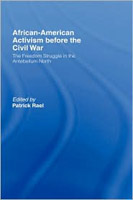
"African American Activism," edited by Patrick Rael, focuses more narrowly on changing historical interpretations of the nature of black protest in the antebellum North. This volume contains the most significant essays on the topic published since the 1960s. It includes an introductory essay by Rael and thirteen interpretive essays arranged according to the original date of publication. Themes of the essays include the extent of white-black cooperation in the abolitionist movement (Leon Litwack), the issue of integration versus separatism (Jane Pease and William Pease), the role of uplift and respectability (Frederick Cooper), African American nationalism (George Leveque, Ernest Allen, Jr.), African American gender relations (James Horton), the political significance of slave resistance (James Oakes), Christianity and identity (Albert J. Raboteau), the impact of whiteness on black community making (Emma Lapansky, James Brewer Stewart, and Leslie Harris), and the relationship of black leadership to the market culture (Rael). All students of African American history should be familiar with these essays. "African American Activism" is best suited for an advanced undergraduate or graduate class concentrating on historiographical interpretation in classes on African American history or politics.
Copyright (c) 2011 by H-Net, all rights reserved. H-Net permits the redistribution and reprinting of this work for nonprofit, educational purposes. This work is licensed under a Creative Commons Attribution-Noncommercial-No Derivative Works 3.0 United States License.
[Return to table of contents]
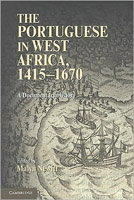
H-NET BOOK REVIEW
Published by H-Africa, http://www.h-net.org/~africa/ (Jan. 2011).
Malyn Newitt, ed. The Portuguese in West Africa, 1415-1670: A Documentary History. New York Cambridge University Press, 2010. 264 pp. $90.00 (cloth), ISBN 978-0-521-76894-8; $27.99 (paper), ISBN 978-0-521-15914-2.
Reviewed for H-Africa by Liam M. Brockey, Michigan State University
Documents on the Portuguese in West Africa
Of all the fragments that comprise the field of global history, the past of the Portuguese-speaking world is one of the least well known. Indeed, knowledge of it among scholars in the Anglo-American or French traditions seems to exist in inverse proportion to the vast scale of the regions once held under the sway of Portuguese political or religious influence. Several reasons exist for this state of affairs, but the primary one is that there are few specialists with competence in the Portuguese language. A secondary, yet perhaps no less important, reason consists in the fact that the accretions of different European presences in Asia and a lengthy history of independence in Brazil have largely suppressed the memory of the Portuguese colonial legacy. Yet if there is one world region where Lusophone history cannot be relegated to a marginal status it is Africa, where the duration of the Portuguese presence from the fifteenth until the twentieth century has ensured that new scholarship must continually engage with the colonial legacy. Specialists who analyze the past in Mozambique, Angola, Guinea, Cape Verde, and elsewhere have recourse to a rich historiographical tradition. But there are few points of entry into this literature for those not trained in Portuguese, and even fewer for undergraduate students or scholars in other fields seeking terms for comparison. Malyn Newitt's new book therefore fills a considerable lacuna for those seeking to explore the documental legacy of the Portuguese presence in Western Africa.
The Portuguese in West Africa, 1415-1670 is the latest installment in a set of useful material rendered into English and accessibly priced by Cambridge University Press for the university teaching market. The book is a collection of translated excerpts of primary source documents related to the major areas of Portuguese influence along the African Atlantic coast from Morocco to Angola. The chronological frame spans the first half of the history of the Portuguese Empire in Africa, and the documents touch on aspects of politics, diplomacy, trade, and missionization. The order of the texts is more thematic than chronological, surveying related subjects in a coherent order and following the progress of Portuguese colonial expansion southward along the Atlantic coast. Newitt offers a succinct overview of the Portuguese presence in West Africa as a preface, where he indicates unifying themes (with organizing references) and sketches a general framework for understanding the collection. What is most appealing about this volume, however, is its depth of coverage. Equal attention is given to the early fifteenth century in Morocco, the later fifteenth century in Guinea and El Mina, the sixteenth century in Kongo, and the seventeenth century in Angola. The amount of space devoted to the North African conquests is especially important, since it offers the reader a series of contrasts between late medieval and early modern patterns of conquest and expansion.
True to its title, this book is a documentary history. The documents range from one paragraph to several pages. A brief illuminating essay that gives the context and identifies the individuals mentioned precedes each selection. References are given to the original sources in Portuguese, Italian, and German, typically in modern printed editions, but at times in archival collections. All of the documents have been translated afresh by the author. Thankfully, they have been done in fluid, modern prose, instead of the archaizing forms often used by translators to make the tone of their text sound more authentically early modern. Newitt also deserves thanks for his decision to avoid using early modern English translations of the selected texts, thereby sparing the reader the ambiguities inherent in Elizabethan or Jacobean prose. The selections in The Portuguese in West Africa are further annotated, perhaps a bit too sparingly to the taste of this reviewer, but sufficient for the didactic purposes of this volume. There is a short bibliography of related works, as well as books containing other primary sources in translation or in the original, and a glossary of Portuguese or African terms which repeats the information found in the footnotes.
The sources selected by Newitt present a range of historical voices from official court chronicles (Gomes Eanes de Zurara's works loom large in the early sections) to diplomatic correspondence (both to and from Lisbon and Rome), to missionary reports (primarily by Jesuits), and finally to colonial histories (Antonio de Oliveira de Cadornega's Historia Geral das Guerras Angolanas [1680] and Filippo Pigafetta's Relatione del Reame di Congo [1591] hold pride of place). While there is a lack of female voices, there is no want for women in the sources. The book contains ample discussions of different regional societies, and the sources offer many vivid details of the African cultures and polities with which the Portuguese came into contact. Of all of the regions discussed, the core of this volume is devoted to the relations between Portugal and the Kingdom of Kongo, and the sources touch on matters religious, diplomatic, economic, and military over the period from the late fifteenth until the late seventeenth century. From the perspective of undergraduate teaching, this volume is most appealing for its insistence on European knowledge about the variety of cultures in West Africa; its depiction of the different modes of interaction between Europeans and Africans, whether peaceful, violent, or neutral; and its underscoring of the crucial role played by diplomacy throughout West Africa.
Newitt is a senior scholar of the Portuguese Empire and, in particular, Portuguese East Africa. His new collection of excerpts from primary sources represents yet another example of his long commitment to the historical profession. Not only has he written major histories of Mozambique, Portugal, and the Portuguese Empire, but he also has produced or collaborated in a number of sourcebooks which are ideal for teaching undergraduates and useful for scholars not trained in Portuguese. The Portuguese in West Africa is the companion volume to an earlier work entitled East Africa, published by Ashgate (2002), which was originally intended as part of the discontinued series, Portuguese Encounters with the World in the Age of the Discoveries, edited by John Villiers. That he pursued the publication of his new volume with Cambridge University Press is a testament to Newitt's commitment to his field.
The appearance of The Portuguese in West Africa provides an opportunity to consider this book in the context of other recent projects aimed at publishing Portuguese documents in English. Ashgate's was perhaps the most ambitious series, and it is a shame that the publisher did not follow through with plans for all of its projected volumes. The three that were printed are useful, if uneven in quality. The volume called China and Macau (2002), edited by Clive Willis, relies heavily on sources that have long been available in the Hakluyt Society's publications, and Newitt's collection on East Africa uses many documents previously translated by other scholars, notably, G. M. Theal's Records of South-East Africa (9 vols., 1898-1903), but also including sources rendered into English by E. G. Ravenstein and C. R. Boxer. A third volume, Portuguese Encounters with Sri Lanka and the Maldives (2009), was edited by Chandra da Silva, and primarily contains polished versions of translated sources from other edited collections. For this reviewer, the greatest flaw of the Ashgate volumes is their price: While they can be found in most research libraries, they are far too expensive to be considered for course adoption at the university level.
Thankfully, Cambridge University Press has realized that the expansion of "World History" as a component of university teaching has created a market for such teaching tools as primary source collections. There is an evident demand for the type of material presented in The Portuguese in West Africa, and Cambridge University Press does well to offer the book in paperback and at a reasonable price. Newitt's book pairs nicely with another refugee from the collapse of the Ashgate project, Stuart Schwartz's Early Brazil: A Documentary Collection to 1700 (2010), but that volume also relies on documents translated by others and regrouped without a concerted effort at standardizing names. One other volume worth mentioning in this context is the recent collection of primary sources edited by Peter Mancall, Travel Narratives from the Age of Discovery: An Anthology (2006). This last volume suffers from the fact that early modern English translations were used instead of new renderings of the sources, putting the burden on the reader to make sense not only of the English prose but also of the confusing terms used by early moderns to describe unfamiliar lands and customs. In sum, there remains a great need for collections of primary sources, in fresh translation, on the early modern Portuguese Empire. The most glaring need is a collection of documents focused on the core regions of the Estado da India during the five centuries of the Portuguese presence in South Asia.
Newitt's _Portuguese in West Africa_ is clearly the best of the recent collections of documents in English about the Portuguese presence in the early modern world. Instructors seeking to include materials about Europe's encounter with Africa before the eighteenth century will find coherent sets of readings here, as well as just enough context to frame effective discussions. And specialists in the history of Anglophone or Francophone Africa should also benefit from the readings on the Portuguese presence in Northwest and West Africa, along with useful bibliographic references. It is hoped that _The Portuguese in West Africa _will serve as an inspiration for other authors in the field of Portuguese history, and a further impetus for publishers to commission new volumes of accessible primary source collections in English for wide audiences.
Copyright (c) 2011 by H-Net, all rights reserved. H-Net permits the redistribution and reprinting of this work for nonprofit, educational purposes. This work is licensed under a Creative Commons Attribution-Noncommercial-No Derivative Works 3.0 United States License.
[Return to table of contents]

©2011 African Diaspora Archaeology Network
Copyright and all rights reserved by
individual authors for each article.
Please send comments, suggestions, or questions
to Chris Fennell at cfennell@illinois.edu
or Christopher Barton at tua94766@temple.edu
Last updated: March 31, 2011
Text only menuSearch
|



